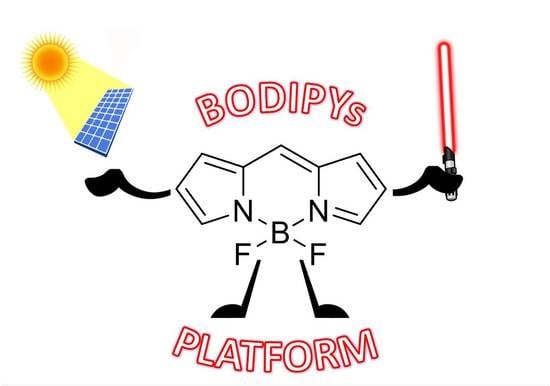BODIPY-Based Molecules, a Platform for Photonic and Solar Cells
Abstract
1. Introduction
- (1)
- BODIPY-based active materials in OPV. Since numerous comprehensive review articles have focused on the synthetic strategy [25] and general working principles of the organic photovoltaic (OPV) devices, in this review we focus more on the analysis of the best results obtained from the first published data in 2009 [26,27] until the last one in 2020 [28,29].
- (2)
- BODIPY-based active materials in photonics devices. In particular, we focus on the work carried out to optimize the lasing performance and photostability in solid-state, as compared to solutions.
2. BODIPY-Based Active Materials in OPV
2.1. BODIPY Molecules as Electron Acceptor Materials in Organic Solar Cells
2.2. BODIPY Molecules as Donor Materials in Organic Solar Cells
| Year | AbsFilmMax Film [nm] | HOMO [eV] | LUMO [eV] | Jsc [mA/cm2] | Voc [V] | FF [%] | PCE [%] | Reference |
|---|---|---|---|---|---|---|---|---|
| 2009 | 572 | −5.69 | −3.66 | 4.7 | 0.866 | 42 | 1.7 | [27] |
| 2009 | 646 | −5.56 | −3.75 | 4.14 | 0.753 | 44 | 1.34 | [26] |
| 2010 | 649 | - | - | 7.00 | 0.75 | 38 | 2.17 | [46] |
| 2011 | 733 | −4.71 | −2.57 | 6.3 | - | 67 | 3.7 | [47] |
| 2012 | 580 | −5.47 | −3.48 | 8.25 | 0.988 | 39.5 | 3.22 | [48] |
| 2012 | 673 | −4.26 | −3.75 | 2.9 | 0.51 | 35 | 0.52 | [49] |
| 2012 | 714 | −5.32 | −3.86 | 14.3 | 0.7 | 47 | 4.70 | [50] |
| 2014 | 748 | −5.00 | −3.59 | 7 | 0.68 | 31 | 1.50 | [51] |
| 2014 | 733 | −5.02 | −3.64 | 6.8 | 0.67 | 34.3 | 1.56 | [52] |
| 2014 | 760 | −5.02 | 3.37 | 8.9 | 0.51 | 34 | 1.5 | [53] |
| 2014 | 643 | −5.31 | −3.50 | 3.39 | 0.71 | 27 | 0.65 | [54] |
| 2015 | 680 | −5.3 | −2.75 | 8.42 | 0.82 | 55 | 3.76 | [55] |
| 2015 | 652 * | −5.62 | −3.52 | 10.48 | 0.9 | 56 | 5.29 | [56] |
| 2015 | 774 | −5.23 | −3.72 | 10.32 | 0.97 | 46.5 | 4.75 | [57] |
| 2015 | 614 | −5.48 | −3.44 | 10.20 | 0.90 | 55 | 5.05 | [58] |
| 2015 | 514 * | −5.33 | −3.86 | 3.03 | 0.81 | 24 | 0.58 | [59] |
| 2015 | 655–792 | −5.01 | −3.73 | 13.39 | 0.73 | 37.3 | 3.6 | [60] |
| 2015 | 761 | −5.34 | −3.66 | 8.17 | 00.85 | 39 | 2.70 | [61] |
| 2015 | 696 | −5.40 | −3.81 | 7.64 | 0.73 | 38 | 2.12 | [62] |
| 2016 | 748 | −5.19 | −3.60 | 6.77 | 0.78 | 41 | 2.15 | [63] |
| 2017 | 627 | −4.93 | −3.28 | 13.79 | 0.768 | 66.5 | 7.2 | [64] |
| 2017 | 550 | −5.11 | −3.65 | 11.84 | 0.73 | 53.8 | 4.61 | [65] |
| 2017 | 765 | −5.26 | −3.91 | 13.9 | 0.64 | 65 | 5.8 | [66] |
| 2017 | 800 | −5.23 | −3.87 | 13.3 | 0.73 | 63 | 6.1 | [42] |
| 2018 | 668 | −5.06 | −3.60 | 12.98 | 0.7 | 62 | 5.61 | [67] |
| 2018 | 720 * | −5.39 | −3.74 | 12.43 ** | 0.88 | 61 | 6.67 | [68] |
| 2018 | 752 * | −5.36 | −3.79 | 14.32 ** | 0.95 | 67 | 8.98 | [68] |
| 2018 | 550–640 | −5.37 | −3.46 | 11.46 ** | 0.915 | 63 | 6.60 | [39] |
| 2019 | 717 | −5.00 | −3.42 | 5.17 | 0.672 | 40.8 | 1.62 | [69] |
| 2019 | 580 | −5.28 | −3.61 | 10.9 | 0.83 | 60 | 5.5 | [70] |
| 2019 | 725 | −5.16 | −3.43 | 7.72 | 1 | 31 | 2.79 | [71] |
| 2019 | 716 | −5.47 | −3.76 | 10.58 | 0.769 | 56.4 | 4.58 | [72] |
| 2020 | 538 | −5.35 | −3.08 | 2.27 | 0.67 | 27 | 0.37 | [73] |
| 2020 | 586 672 * | −5.16 −4.99 | −3.17 −3.27 | 13.56 16.24 | 0.78 0.71 | 61 66 | 6.45 7.61 | [29] |
| 2020 | 586* | −5.91 | −4.09 | 0.87 | 0.45 | 21 | 1.36 | [74] |
| Molecule [Ref.] | Optical Energy GAP [eV] | Treatment | PCE [%] | FF [%] | Hole Mobility [cm2/Vs] | Electron Mobility [cm2/Vs] | Abs. Band [nm] |
|---|---|---|---|---|---|---|---|
| 3 [58] | 1.72 | - | 2.71 | 38 | 7.84 × 10−6 | - | 450–650 |
| TA | 3.99 | 48 | 5.34 × 10−5 | - | |||
| TA + SVA | 5.05 | 55 | 8.45 × 10−5 | - | |||
| 4 [56] | 1.84 | NO | 3.48 | 46 | 8.5 × 10−6 | 2.34 × 10−4 | 350–700 |
| Processed with pyridine 4% v/v | 5.29 | 56 | 8.15 × 10−5 | 2.29 × 10−4 | |||
| 5b [70] | 1.59 | Vacuum processed | 5.5 | 60 | 9.2 × 10−6 | - | 350–1000 |
| 6 [67] | 1.74 | - | 2.74 | 34 | - | - | 300–850 |
| TA | 4.72 | 57 | 2.09 × 10−4 | ||||
| TA +SVA | 5.61 | 62 | 4.37 × 10−4 | ||||
| 7 [66] | 1.52 | TA | 5.8 | 65 | 0.8 × 10−3 | - | 400–800 |
| 8 [42] | 1.32 | Vacuum processed | 6.1 | 63 | - | - | 500–900 |
| 9 [39] | 1.79 | - | 2.54 | 39 | 5.34 × 10−5 | 2.35 × 10−4 | 400–700 |
| SVA | 6.6 | 63 | 1.13 × 10−4 | 2.45 × 10−4 | |||
| 10 [63] | 1.65 | - | 5.3 | 52 | 0.9 × 10−4 | 3.9 × 10−4 | 300–800 |
| TA | 7.2 | 66.5 | 2.1 × 10−4 | 2.8 × 10−4 | |||
| 11a [29] | 1.78 | - | 3.21 | 46 | - | - | 300–600 |
| SVA | 6.45 | 61 | 8.89 × 10−5 | 2.41 × 10−4 | |||
| 11b [29] | 1.58 | - | 3.76 | 48 | / | / | 300–700 |
| SVA | 7.61 | 66 | 1.07 × 10−4 | 2.47 × 10−4 | |||
| 12a [68] | 1.52 | - | 3.32 | 41 | 3.95 × 10−5 | 2.31 × 10−4 | 400–800 |
| SVA | 6.67 | 61 | 1.10 × 10−4 | 2.36 × 10−4 | |||
| 12b [68] | 1.44 | - | 4.73 | 45 | 4.85 × 10−5 | 2.38 × 10−4 | 400–800 |
| SVA | 8.98 | 67 | 1.59 × 10−4 | 2.43 × 10−4 |
3. Photonic Applications
3.1. Fluorescence Emission Optimization in BODIPY Derivatives
3.2. BODIPY Derivatives as Lasing Dyes
3.3. BODIPY as Active Layer in Optical Microcavity
4. Conclusions and Perspectives
Funding
Conflicts of Interest
Abbreviations
| BDT | Benzo[1,2-b:4,5-b’]dithiophene |
| BHJ | Bulk-HeteroJunction solar cells |
| BPAPF | 9,9-bis[4-(N,N-bis-biphenyl-4-yl-amino)phenyl]-9H-fluorene |
| D–A | Donor–Acceptor |
| DCM | Dichloromethane |
| DFB | Distributed Feedback laser |
| DPP | Diketopyrrolopyrrole |
| ETL | Electron Transporting Layer (ETL) |
| FF | Fill Factor |
| HOMO | Highest Occupied Molecular Orbital |
| HTL | Hole Transporting Layer |
| ITO | Indium Tin Oxide |
| Jsc | Short-circuit current Density |
| LUMO | Lowest Unoccupied Molecular Orbital |
| MH250 | N,N-bis(fluoren-2-yl)-naphthalenetetracarboxylic diimide(bis-Hfl-NTCDI) |
| MMA | Methyl Methacrylate |
| MoO3 | Molibdenum Oxide |
| NDP9 | Organic p-type dopant of Novaled GmbH |
| NIR | Near InfraRed |
| OPV | Organic PhotoVoltaic |
| OSC | Organic Solar Cell |
| P3HT | Poly(3-hexylthiophene-2,5-diyl) |
| PAZO-Na | Poly[1-[4-(3-carboxy-4-hydroxyphenylazo)benzenesulfonamido]-1,2-Ethanediyl, sodium salt] |
| PCE | Power Conversion Efficiency |
| p-DTS-(FBTTh2)2 | 7,7′-[4,4-Bis(2-ethylhexyl)-4H-silolo[3,2-b:4,5-b′]dithiophene-2,6-diyl]bis[6-Fluoro-4-(5′-hexyl-[2,2′-bithiophen]-5-yl)benzo[c][1,2,5]thiadiazole] |
| PEDOT:PSS | Poly(3,4-ethylenedioxythiophene) polystyrene sulfonate |
| PEIE | Polyethylenimine ethoxylated |
| PFN | Poly[9,9-bis(3′-(N,N-dimethylamino)propyl)-2,7-fluorene |
| PL | Photoluminescence |
| PMMA | Poly(methyl methacrylate) |
| PTB7-Th | Poly([2,6′-4,8-di(5-ethylhexylthienyl)benzo[1,2-b;3,3-b]dithiophene]{3-fluoro-2[(2-ethylhexyl)carbonyl]thieno[3,4-b]thiophenediyl}) |
| SCLC | Space-Charge Limited-Current |
| SVA | Solvent Vapor Annealing |
| TA | Thermal Annealing |
| TAT | Triazatruxene |
| TF | Thin film |
| TFMA | 2-trifluoromethyl methacrylate |
| TSVA | Thermal and Solvent Annealing |
| Voc | Open Circuit Voltage |
| W2(hpp)4 | Tetrakis(1,3,4,6,7,8-hexahydro-2H-pyrimido[1,2-a]pyrimidinato)ditungsten (II) |
| ZnO | Zinc Oxide |
References
- Semiconducting Polymers: Chemistry, Physics and Engineering, 2nd Edition, Two-Volume Set|Wiley. Available online: https://www.wiley.com/en-us/Semiconducting+Polymers%3A+Chemistry%2C+Physics+and+Engineering%2C+2nd+Edition%2C+Two+Volume+Set-p-9783527312719 (accessed on 24 November 2020).
- Ostroverkhova, O. Organic Optoelectronic Materials: Mechanisms and Applications. Chem. Rev. 2016, 116, 13279–13412. [Google Scholar] [CrossRef] [PubMed]
- Forrest, S.R.; Thompson, M.E. Introduction: Organic Electronics and Optoelectronics. Chem. Rev. 2007, 107, 923–925. [Google Scholar] [CrossRef]
- Zvezdin, A.; Mauro, E.D.; Rho, D.; Santato, C.; Khalil, M. En Route toward Sustainable Organic Electronics. MRS Energy Sustain. 2020, 7. [Google Scholar] [CrossRef]
- Giovanella, U.; Betti, P.; Bolognesi, A.; Destri, S.; Melucci, M.; Pasini, M.; Porzio, W.; Botta, C. Core-Type Polyfluorene-Based Copolymers for Low-Cost Light-Emitting Technologies. Org. Electron. 2010, 11, 2012–2018. [Google Scholar] [CrossRef]
- Vohra, V.; Galeotti, F.; Giovanella, U.; Mróz, W.; Pasini, M.; Botta, C. Nanostructured Light-Emitting Polymer Thin Films and Devices Fabricated by the Environment-Friendly Push-Coating Technique. ACS Appl. Mater. Interfaces 2018, 10, 11794–11800. [Google Scholar] [CrossRef] [PubMed]
- Irimia-Vladu, M. “Green” Electronics: Biodegradable and Biocompatible Materials and Devices for Sustainable Future. Chem. Soc. Rev. 2014, 43, 588–610. [Google Scholar] [CrossRef] [PubMed]
- Treibs, A.; Kreuzer, F.-H. Difluorboryl-Komplexe von Di- Und Tripyrrylmethenen. Justus Liebigs Annalen Chem. 1968, 718, 208–223. [Google Scholar] [CrossRef]
- Banuelos, J. BODIPY dye, the most versatile fluorophore ever? Chem. Rec. 2016, 16, 335–348. [Google Scholar] [CrossRef]
- Loudet, A.; Burgess, K. BODIPY Dyes and Their Derivatives: Syntheses and Spectroscopic Properties. Chem. Rev. 2007, 107, 4891–4932. [Google Scholar] [CrossRef]
- Squeo, B.M.; Gregoriou, V.G.; Avgeropoulos, A.; Baysec, S.; Allard, S.; Scherf, U.; Chochos, C.L. BODIPY-Based Polymeric Dyes as Emerging Horizon Materials for Biological Sensing and Organic Electronic Applications. Prog. Polym. Sci. 2017, 71, 26–52. [Google Scholar] [CrossRef]
- Squeo, B.M.; Pasini, M. BODIPY Platform: A Tunable Tool for Green to NIR OLEDs. Supramol. Chem. 2020, 32, 56–70. [Google Scholar] [CrossRef]
- Menges, N. Computational Study on Aromaticity and Resonance Structures of Substituted BODIPY Derivatives. Comput. Theor. Chem. 2015, 1068, 117–122. [Google Scholar] [CrossRef]
- Ulrich, G.; Ziessel, R.; Harriman, A. The Chemistry of Fluorescent Bodipy Dyes: Versatility Unsurpassed. Angew. Chem. Int. Ed. 2008, 47, 1184–1201. [Google Scholar] [CrossRef] [PubMed]
- Poddar, M.; Misra, R. Recent Advances of BODIPY Based Derivatives for Optoelectronic Applications. Coord. Chem. Rev. 2020, 421, 213462. [Google Scholar] [CrossRef]
- Singh, A.; Yip, W.-T.; Halterman, R.L. Fluorescence-On Response via CB7 Binding to Viologen–Dye Pseudorotaxanes. Org. Lett. 2012, 14, 4046–4049. [Google Scholar] [CrossRef]
- Frath, D.; Yarnell, J.E.; Ulrich, G.; Castellano, F.N.; Ziessel, R. Ultrafast Photoinduced Electron Transfer in Viologen-Linked BODIPY Dyes. ChemPhysChem 2013, 14, 3348–3354. [Google Scholar] [CrossRef]
- Tao, J.; Sun, D.; Sun, L.; Li, Z.; Fu, B.; Liu, J.; Zhang, L.; Wang, S.; Fang, Y.; Xu, H. Tuning the Photo-Physical Properties of BODIPY Dyes: Effects of 1, 3, 5, 7- Substitution on Their Optical and Electrochemical Behaviours. Dyes Pigment. 2019, 168, 166–174. [Google Scholar] [CrossRef]
- Llano, R.S.; Zaballa, E.A.; Bañuelos, J.; Durán, C.F.A.G.; Vázquez, J.L.B.; Cabrera, E.P.; Arbeloa, I.L. Tailoring the Photophysical Signatures of BODIPY Dyes: Toward Fluorescence Standards across the Visible Spectral Region. Photochem. Photophys. Fundam. Appl. 2018. [Google Scholar] [CrossRef]
- Littler, B.J.; Miller, M.A.; Hung, C.-H.; Wagner, R.W.; O’Shea, D.F.; Boyle, P.D.; Lindsey, J.S. Refined Synthesis of 5-Substituted Dipyrromethanes. J. Org. Chem. 1999, 64, 1391–1396. [Google Scholar] [CrossRef]
- Shimizu, S.; Iino, T.; Araki, Y.; Kobayashi, N. Pyrrolopyrrole Aza-BODIPY Analogues: A Facile Synthesis and Intense Fluorescence. Chem. Commun. 2013, 49, 1621–1623. [Google Scholar] [CrossRef]
- Adarsh, N.; Shanmugasundaram, M.; Avirah, R.R.; Ramaiah, D. Aza-BODIPY Derivatives: Enhanced Quantum Yields of Triplet Excited States and the Generation of Singlet Oxygen and Their Role as Facile Sustainable Photooxygenation Catalysts. Chem. A Eur. J. 2012, 18, 12655–12662. [Google Scholar] [CrossRef] [PubMed]
- Ho, D.; Ozdemir, R.; Kim, H.; Earmme, T.; Usta, H.; Kim, C. BODIPY-Based Semiconducting Materials for Organic Bulk Heterojunction Photovoltaics and Thin-Film Transistors. ChemPlusChem 2019, 84, 18–37. [Google Scholar] [CrossRef] [PubMed]
- Wanwong, S.; Sangkhun, W.; Kumnorkaew, P.; Wootthikanokkhan, J. Improved Performance of Ternary Solar Cells by Using BODIPY Triads. Materials 2020, 13, 2723. [Google Scholar] [CrossRef]
- Boens, N.; Verbelen, B.; Dehaen, W. Postfunctionalization of the BODIPY Core: Synthesis and Spectroscopy. Eur. J. Org. Chem. 2015, 2015, 6577–6595. [Google Scholar] [CrossRef]
- Rousseau, T.; Cravino, A.; Bura, T.; Ulrich, G.; Ziessel, R.; Roncali, J. BODIPY Derivatives as Donor Materials for Bulk Heterojunction Solar Cells. Chem. Commun. 2009, 1673. [Google Scholar] [CrossRef] [PubMed]
- Rousseau, T.; Cravino, A.; Bura, T.; Ulrich, G.; Ziessel, R.; Roncali, J. Multi-Donor Molecular Bulk Heterojunction Solar Cells: Improving Conversion Efficiency by Synergistic Dye Combinations. J. Mater. Chem. 2009, 19, 2298–2300. [Google Scholar] [CrossRef]
- Liu, B.; Ma, Z.; Xu, Y.; Guo, Y.; Yang, F.; Xia, D.; Li, C.; Tang, Z.; Li, W. Non-Fullerene Organic Solar Cells Based on a BODIPY-Polymer as Electron Donor with High Photocurrent. J. Mater. Chem. C 2020, 8, 2232–2237. [Google Scholar] [CrossRef]
- Yang, J.; Devillers, C.H.; Fleurat-Lessard, P.; Jiang, H.; Wang, S.; Gros, C.P.; Gupta, G.; Sharma, G.D.; Xu, H. Carbazole-Based Green and Blue-BODIPY Dyads and Triads as Donors for Bulk Heterojunction Organic Solar Cells. Dalton Trans. 2020, 49, 5606–5617. [Google Scholar] [CrossRef]
- Liu, Q.; Jiang, Y.; Jin, K.; Qin, J.; Xu, J.; Li, W.; Xiong, J.; Liu, J.; Xiao, Z.; Sun, K.; et al. 18% Efficiency Organic Solar Cells. Sci. Bull. 2020, 65, 272–275. [Google Scholar] [CrossRef]
- Clarke, T.M.; Durrant, J.R. Charge Photogeneration in Organic Solar Cells. Chem. Rev. 2010, 110, 6736–6767. [Google Scholar] [CrossRef]
- Achieving a High Fill Factor for Organic Solar Cells—Journal of Materials Chemistry A (RSC Publishing). Available online: https://pubs.rsc.org/en/content/articlelanding/2016/ta/c6ta00126b#!divAbstract (accessed on 24 November 2020).
- Squeo, B.M.; Gregoriou, V.G.; Han, Y.; Palma-Cando, A.; Allard, S.; Serpetzoglou, E.; Konidakis, I.; Stratakis, E.; Avgeropoulos, A.; Heeney, M.; et al. α,β-Unsubstituted Meso -Positioning Thienyl BODIPY: A Promising Electron Deficient Building Block for the Development of near Infrared (NIR) p-Type Donor–Acceptor (D–A) Conjugated Polymers. J. Mater. Chem. C 2018, 6, 4030–4040. [Google Scholar] [CrossRef]
- Zampetti, A.; Minotto, A.; Squeo, B.M.; Gregoriou, V.G.; Allard, S.; Scherf, U.; Chochos, C.L.; Cacialli, F. Highly Efficient Solid-State Near-Infrared Organic Light-Emitting Diodes Incorporating A-D-A Dyes Based on α,β -Unsubstituted “BODIPY” Moieties. Sci. Rep. 2017, 7, 1611. [Google Scholar] [CrossRef] [PubMed]
- Chochos, C.L.; Drakopoulou, S.; Katsouras, A.; Squeo, B.M.; Sprau, C.; Colsmann, A.; Gregoriou, V.G.; Cando, A.-P.; Allard, S.; Scherf, U.; et al. Beyond Donor–Acceptor (D–A) Approach: Structure–Optoelectronic Properties—Organic Photovoltaic Performance Correlation in New D–A1–D–A2 Low-Bandgap Conjugated Polymers. Macromol. Rapid Commun. 2017, 38, 1600720. [Google Scholar] [CrossRef]
- Mahesh, K.; Karpagam, S.; Pandian, K. How to Design Donor–Acceptor Based Heterocyclic Conjugated Polymers for Applications from Organic Electronics to Sensors. Top. Curr. Chem. 2019, 377, 12. [Google Scholar] [CrossRef]
- Salzner, U. Effect of Donor–Acceptor Substitution on Optoelectronic Properties of Conducting Organic Polymers. J. Chem. Theory Comput. 2014, 10, 4921–4937. [Google Scholar] [CrossRef]
- Porzio, W.; Destri, S.; Pasini, M.; Giovanella, U.; Ragazzi, M.; Scavia, G.; Kotowski, D.; Zotti, G.; Vercelli, B. Synthesis and Characterisation of Fluorenone–Thiophene-Based Donor–Acceptor Oligomers: Role of Moiety Sequence upon Packing and Electronic Properties. New J. Chem. 2010, 34, 1961–1973. [Google Scholar] [CrossRef]
- Mishra, R.; Basumatary, B.; Singhal, R.; Sharma, G.D.; Sankar, J. Corrole-BODIPY Dyad as Small-Molecule Donor for Bulk Heterojunction Solar Cells. ACS Appl. Mater. Interfaces 2018, 10, 31462–31471. [Google Scholar] [CrossRef]
- Squeo, B.M.; Carulli, F.; Lassi, E.; Galeotti, F.; Giovanella, U.; Luzzati, S.; Pasini, M. Benzothiadiazole-Based Conjugated Polyelectrolytes for Interfacial Engineering in Optoelectronic Devices. Pure Appl. Chem. 2019, 91, 477–488. [Google Scholar] [CrossRef]
- Carulli, F.; Scavia, G.; Lassi, E.; Pasini, M.; Galeotti, F.; Brovelli, S.; Giovanella, U.; Luzzati, S. A Bifunctional Conjugated Polyelectrolyte for the Interfacial Engineering of Polymer Solar Cells. J. Colloid Interface Sci. 2019, 538, 611–619. [Google Scholar] [CrossRef]
- Li, T.; Meyer, T.; Ma, Z.; Benduhn, J.; Körner, C.; Zeika, O.; Vandewal, K.; Leo, K. Small Molecule Near-Infrared Boron Dipyrromethene Donors for Organic Tandem Solar Cells. J. Am. Chem. Soc. 2017, 139, 13636–13639. [Google Scholar] [CrossRef]
- Lin, Y.; Li, Y.; Zhan, X. Small Molecule Semiconductors for High-Efficiency Organic Photovoltaics. Chem. Soc. Rev. 2012, 41, 4245–4272. [Google Scholar] [CrossRef]
- Poe, A.M.; Pelle, A.M.D.; Subrahmanyam, A.V.; White, W.; Wantz, G.; Thayumanavan, S. Small Molecule BODIPY Dyes as Non-Fullerene Acceptors in Bulk Heterojunction Organic Photovoltaics. Chem. Commun. 2014, 50, 2913–2915. [Google Scholar] [CrossRef]
- Liu, W.; Yao, J.; Zhan, C. A Novel BODIPY-Based Low-Band-Gap Small-Molecule Acceptor for Efficient Non-fullerene Polymer Solar Cells. Chin. J. Chem. 2017, 35, 1813–1823. [Google Scholar] [CrossRef]
- Rousseau, T.; Cravino, A.; Ripaud, E.; Leriche, P.; Rihn, S.; Nicola, A.D.; Ziessel, R.; Roncali, J. A Tailored Hybrid BODIPY–Oligothiophene Donor for Molecular Bulk Heterojunction Solar Cells with Improved Performances. Chem. Commun. 2010, 46, 5082–5084. [Google Scholar] [CrossRef]
- Kubo, Y.; Watanabe, K.; Nishiyabu, R.; Hata, R.; Murakami, A.; Shoda, T.; Ota, H. Near-Infrared Absorbing Boron-Dibenzopyrromethenes That Serve As Light-Harvesting Sensitizers for Polymeric Solar Cells. Org. Lett. 2011, 13, 4574–4577. [Google Scholar] [CrossRef] [PubMed]
- Lin, H.-Y.; Huang, W.-C.; Chen, Y.-C.; Chou, H.-H.; Hsu, C.-Y.; Lin, J.T.; Lin, H.-W. BODIPY Dyes with β-Conjugation and Their Applications for High-Efficiency Inverted Small Molecule Solar Cells. Chem. Commun. 2012, 48, 8913. [Google Scholar] [CrossRef] [PubMed]
- Hayashi, Y.; Obata, N.; Tamaru, M.; Yamaguchi, S.; Matsuo, Y.; Saeki, A.; Seki, S.; Kureishi, Y.; Saito, S.; Yamaguchi, S.; et al. Facile Synthesis of Biphenyl-Fused BODIPY and Its Property. Org. Lett. 2012, 14, 866–869. [Google Scholar] [CrossRef] [PubMed]
- Bura, T.; Leclerc, N.; Fall, S.; Lévêque, P.; Heiser, T.; Retailleau, P.; Rihn, S.; Mirloup, A.; Ziessel, R. High-Performance Solution-Processed Solar Cells and Ambipolar Behavior in Organic Field-Effect Transistors with Thienyl-BODIPY Scaffoldings. J. Am. Chem. Soc. 2012, 134, 17404–17407. [Google Scholar] [CrossRef] [PubMed]
- Kolemen, S.; Cakmak, Y.; Ozdemir, T.; Erten-Ela, S.; Buyuktemiz, M.; Dede, Y.; Akkaya, E.U. Design and Characterization of Bodipy Derivatives for Bulk Heterojunction Solar Cells. Tetrahedron 2014, 70, 6229–6234. [Google Scholar] [CrossRef]
- Liu, W.; Tang, A.; Chen, J.; Wu, Y.; Zhan, C.; Yao, J. Photocurrent Enhancement of BODIPY-Based Solution-Processed Small-Molecule Solar Cells by Dimerization via the Meso Position. ACS Appl. Mater. Interfaces 2014, 6, 22496–22505. [Google Scholar] [CrossRef]
- Sutter, A.; Retailleau, P.; Huang, W.-C.; Lin, H.-W.; Ziessel, R. Photovoltaic Performance of Novel Push–Pull–Push Thienyl–Bodipy Dyes in Solution-Processed BHJ-Solar Cells. New J. Chem. 2014, 38, 1701–1710. [Google Scholar] [CrossRef]
- Cortizo-Lacalle, D.; Howells, C.T.; Pandey, U.K.; Cameron, J.; Findlay, N.J.; Inigo, A.R.; Tuttle, T.; Skabara, P.J.; Samuel, I.D.W. Solution Processable Diketopyrrolopyrrole (DPP) Cored Small Molecules with BODIPY End Groups as Novel Donors for Organic Solar Cells. Beilstein J. Org. Chem. 2014, 10, 2683–2695. [Google Scholar] [CrossRef] [PubMed]
- Chen, J.J.; Conron, S.M.; Erwin, P.; Dimitriou, M.; McAlahney, K.; Thompson, M.E. High-Efficiency BODIPY-Based Organic Photovoltaics. ACS Appl. Mater. Interfaces 2015, 7, 662–669. [Google Scholar] [CrossRef] [PubMed]
- Sharma, G.D.; Siddiqui, S.A.; Nikiforou, A.; Zervaki, G.E.; Georgakaki, I.; Ladomenou, K.; Coutsolelos, A.G. A Mono(Carboxy)Porphyrin-Triazine-(Bodipy) 2 Triad as a Donor for Bulk Heterojunction Organic Solar Cells. J. Mater. Chem. C 2015, 3, 6209–6217. [Google Scholar] [CrossRef]
- Xiao, L.; Wang, H.; Gao, K.; Li, L.; Liu, C.; Peng, X.; Wong, W.-Y.; Wong, W.-K.; Zhu, X. A-D-A Type Small Molecules Based on Boron Dipyrromethene for Solution-Processed Organic Solar Cells. Chem. Asian J. 2015, 10, 1513–1518. [Google Scholar] [CrossRef] [PubMed]
- Jadhav, T.; Misra, R.; Biswas, S.; Sharma, G.D. Bulk Heterojunction Organic Solar Cells Based on Carbazole–BODIPY Conjugate Small Molecules as Donors with High Open Circuit Voltage. Phys. Chem. Chem. Phys. 2015, 17, 26580–26588. [Google Scholar] [CrossRef] [PubMed]
- Zou, L.; Guan, S.; Li, L.; Zhao, L. Dipyrrin-Based Complexes for Solution-Processed Organic Solar Cells. Chem. Res. Chin. Univ. 2015, 31, 801–808. [Google Scholar] [CrossRef]
- Liu, W.; Yao, J.; Zhan, C. Performance Enhancement of BODIPY Dimer-Based Small-Molecule Solar Cells Using a Visible-Photon-Capturing Diketopyrrolopyrrole π-Bridge. RSC Adv. 2015, 5, 74238–74241. [Google Scholar] [CrossRef]
- Zhang, X.; Zhang, Y.; Chen, L.; Xiao, Y. Star-Shaped Carbazole-Based BODIPY Derivatives with Improved Hole Transportation and near-Infrared Absorption for Small-Molecule Organic Solar Cells with High Open-Circuit Voltages. RSC Adv. 2015, 5, 32283–32289. [Google Scholar] [CrossRef]
- Liao, J.; Xu, Y.; Zhao, H.; Wang, Y.; Zhang, W.; Peng, F.; Xie, S.; Yang, X. Synthesis, Optical, Electrochemical Properties and Photovoltaic Performance of Novel Panchromatic Meso-Thiophene BODIPY Dyes with a Variety of Electron-Donating Groups at the 3,5-Positions. RSC Adv. 2015, 5, 86453–86462. [Google Scholar] [CrossRef]
- Liao, J.; Zhao, H.; Xu, Y.; Cai, Z.; Peng, Z.; Zhang, W.; Zhou, W.; Li, B.; Zong, Q.; Yang, X. Novel D–A–D Type Dyes Based on BODIPY Platform for Solution Processed Organic Solar Cells. Dyes Pigment. 2016, 128, 131–140. [Google Scholar] [CrossRef]
- Rao, R.S.; Bagui, A.; Rao, G.H.; Gupta, V.; Singh, S.P. Achieving the Highest Efficiency Using a BODIPY Core Decorated with Dithiafulvalene Wings for Small Molecule Based Solution-Processed Organic Solar Cells. Chem. Commun. 2017, 53, 6953–6956. [Google Scholar] [CrossRef]
- Liao, J.; Xu, Y.; Zhao, H.; Zong, Q.; Fang, Y. Novel A-D-A Type Small Molecules with β-Alkynylated BODIPY Flanks for Bulk Heterojunction Solar Cells. Org. Electron. 2017, 49, 321–333. [Google Scholar] [CrossRef]
- Bulut, I.; Huaulmé, Q.; Mirloup, A.; Chávez, P.; Fall, S.; Hébraud, A.; Méry, S.; Heinrich, B.; Heiser, T.; Lévêque, P.; et al. Rational Engineering of BODIPY-Bridged Trisindole Derivatives for Solar Cell Applications. ChemSusChem 2017, 10, 1878–1882. [Google Scholar] [CrossRef]
- Liao, J.; Zhao, H.; Cai, Z.; Xu, Y.; Qin, F.G.F.; Zong, Q.; Peng, F.; Fang, Y. BODIPY-Based Panchromatic Chromophore for Efficient Organic Solar Cell. Org. Electron. 2018, 61, 215–222. [Google Scholar] [CrossRef]
- Bucher, L.; Desbois, N.; Koukaras, E.N.; Devillers, C.H.; Biswas, S.; Sharma, G.D.; Gros, C.P. BODIPY–Diketopyrrolopyrrole–Porphyrin Conjugate Small Molecules for Use in Bulk Heterojunction Solar Cells. J. Mater. Chem. A 2018, 6, 8449–8461. [Google Scholar] [CrossRef]
- Marques dos Santos, J.; Jagadamma, L.K.; Latif, N.M.; Ruseckas, A.; Samuel, I.D.W.; Cooke, G. BODIPY Derivatives with near Infra-Red Absorption as Small Molecule Donors for Bulk Heterojunction Solar Cells. RSC Adv. 2019, 9, 15410–15423. [Google Scholar] [CrossRef]
- Li, T.; Benduhn, J.; Qiao, Z.; Liu, Y.; Li, Y.; Shivhare, R.; Jaiser, F.; Wang, P.; Ma, J.; Zeika, O.; et al. Effect of H- and J-Aggregation on the Photophysical and Voltage Loss of Boron Dipyrromethene Small Molecules in Vacuum-Deposited Organic Solar Cells. J. Phys. Chem. Lett. 2019, 10, 2684–2691. [Google Scholar] [CrossRef]
- Aguiar, A.; Farinhas, J.; da Silva, W.; Ghica, M.E.; Brett, C.M.A.; Morgado, J.; Sobral, A.J.F.N. Synthesis, Characterization and Application of Meso-Substituted Fluorinated Boron Dipyrromethenes (BODIPYs) with Different Styryl Groups in Organic Photovoltaic Cells. Dyes Pigment. 2019, 168, 103–110. [Google Scholar] [CrossRef]
- Thumuganti, G.; Gupta, V.; Singh, S.P. New Dithienosilole- and Dithienogermole-Based BODIPY for Solar Cell Applications. New J. Chem. 2019, 43, 8735–8740. [Google Scholar] [CrossRef]
- Aguiar, A.; Farinhas, J.; da Silva, W.; Susano, M.; Silva, M.R.; Alcácer, L.; Kumar, S.; Brett, C.M.A.; Morgado, J.; Sobral, A.J.F.N. Simple BODIPY Dyes as Suitable Electron-Donors for Organic Bulk Heterojunction Photovoltaic Cells. Dyes Pigment. 2020, 172, 107842. [Google Scholar] [CrossRef]
- Ivaniuk, K.; Pidluzhna, A.; Stakhira, P.; Baryshnikov, G.V.; Kovtun, Y.P.; Hotra, Z.; Minaev, B.F.; Ågren, H. BODIPY-Core 1,7-Diphenyl-Substituted Derivatives for Photovoltaics and OLED Applications. Dyes Pigment. 2020, 175, 108123. [Google Scholar] [CrossRef]
- Würthner, F.; Kaiser, T.E.; Saha-Möller, C.R. J-Aggregates: From Serendipitous Discovery to Supramolecular Engineering of Functional Dye Materials. Angew. Chem. Int. Ed. 2011, 50, 3376–3410. [Google Scholar] [CrossRef] [PubMed]
- Ding, T.; Alemán, E.A.; Modarelli, D.A.; Ziegler, C.J. Photophysical Properties of a Series of Free-Base Corroles. J. Phys. Chem. A 2005, 109, 7411–7417. [Google Scholar] [CrossRef]
- Ray, C.; Díaz-Casado, L.; Avellanal-Zaballa, E.; Bañuelos, J.; Cerdán, L.; García-Moreno, I.; Moreno, F.; Maroto, B.L.; López-Arbeloa, Í.; de la Moya, S. N-BODIPYs Come into Play: Smart Dyes for Photonic Materials. Chem. A Eur. J. 2017, 23, 9383–9390. [Google Scholar] [CrossRef]
- Kuznetsova, R.T.; Aksenova, I.V.; Prokopenko, A.A.; Pomogaev, V.A.; Antina, E.V.; Berezin, M.B.; Antina, L.A.; Bumagina, N.A. Photonics of Boron(III) and Zinc(II) Dipyrromethenates as Active Media for Modern Optical Devices. J. Mol. Liq. 2019, 278, 5–11. [Google Scholar] [CrossRef]
- Kuehne, A.J.C.; Gather, M.C. Organic Lasers: Recent Developments on Materials, Device Geometries, and Fabrication Techniques. Chem. Rev. 2016, 116, 12823–12864. [Google Scholar] [CrossRef]
- Pasini, M.; Giovanella, U.; Betti, P.; Bolognesi, A.; Botta, C.; Destri, S.; Porzio, W.; Vercelli, B.; Zotti, G. The Role of Triphenylamine in the Stabilization of Highly Efficient Polyfluorene-Based OLEDs: A Model Oligomers Study. ChemPhysChem 2009, 10, 2143–2149. [Google Scholar] [CrossRef]
- Jakubiak, R.; Bao, Z.; Rothberg, L. Dendritic Sidegroups as Three-Dimensional Barriers to Aggregation Quenching of Conjugated Polymer Fluorescence. Synth. Metals 2000, 114, 61–64. [Google Scholar] [CrossRef]
- Ozdemir, T.; Atilgan, S.; Kutuk, I.; Yildirim, L.T.; Tulek, A.; Bayindir, M.; Akkaya, E.U. Solid-State Emissive BODIPY Dyes with Bulky Substituents As Spacers. Org. Lett. 2009, 11, 2105–2107. [Google Scholar] [CrossRef]
- Lu, H.; Wang, Q.; Gai, L.; Li, Z.; Deng, Y.; Xiao, X.; Lai, G.; Shen, Z. Tuning the Solid-State Luminescence of BODIPY Derivatives with Bulky Arylsilyl Groups: Synthesis and Spectroscopic Properties. Chem. A Eur. J. 2012, 18, 7852–7861. [Google Scholar] [CrossRef] [PubMed]
- Vu, T.T.; Dvorko, M.; Schmidt, E.Y.; Audibert, J.-F.; Retailleau, P.; Trofimov, B.A.; Pansu, R.B.; Clavier, G.; Méallet-Renault, R. Understanding the Spectroscopic Properties and Aggregation Process of a New Emitting Boron Dipyrromethene (BODIPY). J. Phys. Chem. C 2013, 117, 5373–5385. [Google Scholar] [CrossRef]
- Xi, H.; Yuan, C.-X.; Li, Y.-X.; Liu, Y.; Tao, X.-T. Crystal Structures and Solid-State Fluorescence of BODIPY Dyes Based on Λ-Shaped Tröger’s Base. CrystEngComm 2012, 14, 2087–2093. [Google Scholar] [CrossRef]
- Pasini, M.; Destri, S.; Porzio, W.; Botta, C.; Giovanella, U. Electroluminescent Poly(Fluorene-Co-Thiophene-S,S-Dioxide): Synthesis, Characterisation and Structure–Property Relationships. J. Mater. Chem. 2003, 13, 807–813. [Google Scholar] [CrossRef]
- Mukherjee, S.; Thilagar, P. Tuning the Solid State Emission of Meso-Me3SiC6H4 BODIPYs by Tuning Their Solid State Structure. J. Mater. Chem. C 2013, 1, 4691–4698. [Google Scholar] [CrossRef]
- Manzano, H.; Esnal, I.; Marqués-Matesanz, T.; Bañuelos, J.; López-Arbeloa, I.; Ortiz, M.J.; Cerdán, L.; Costela, A.; García-Moreno, I.; Chiara, J.L. Unprecedented j-aggregated dyes in pure organic solvents. Adv. Funct. Mater. 2016, 26, 2756–2769. [Google Scholar] [CrossRef]
- Bozdemir, Ö.A.; Al-Sharif, H.H.T.; McFarlane, W.; Waddell, P.G.; Benniston, A.C.; Harriman, A. Solid-State Emission from Mono- and Bichromophoric Boron Dipyrromethene (BODIPY) Derivatives and Comparison with Fluid Solution. Chem. A Eur. J. 2019, 25, 15634–15645. [Google Scholar] [CrossRef]
- Musser, A.J.; Rajendran, S.K.; Georgiou, K.; Gai, L.; Grant, R.T.; Shen, Z.; Cavazzini, M.; Ruseckas, A.; Turnbull, G.A.; Samuel, I.D.W.; et al. Intermolecular States in Organic Dye Dispersions: Excimers vs. Aggregates. J. Mater. Chem. C 2017, 5, 8380–8389. [Google Scholar] [CrossRef]
- Yuan, K.; Wang, X.; Mellerup, S.K.; Kozin, I.; Wang, S. Spiro-BODIPYs with a Diaryl Chelate: Impact on Aggregation and Luminescence. J. Org. Chem. 2017, 82, 13481–13487. [Google Scholar] [CrossRef]
- Gómez-Durán, C.F.A.; García-Moreno, I.; Costela, A.; Martin, V.; Sastre, R.; Bañuelos, J.; Arbeloa, F.L.; Arbeloa, I.L.; Peña-Cabrera, E. 8-PropargylaminoBODIPY: Unprecedented Blue-Emitting Pyrromethene Dye. Synthesis, Photophysics and Laser Properties. Chem. Commun. 2010, 46, 5103–5105. [Google Scholar] [CrossRef]
- Esnal, I.; Valois-Escamilla, I.; Gómez-Durán, C.F.A.; Urías-Benavides, A.; Betancourt-Mendiola, M.L.; López-Arbeloa, I.; Bañuelos, J.; García-Moreno, I.; Costela, A.; Peña-Cabrera, E. Blue-to-Orange Color-Tunable Laser Emission from Tailored Boron-Dipyrromethene Dyes. Chemphyschem 2013, 14, 4134–4142. [Google Scholar] [CrossRef] [PubMed]
- Belmonte-Vázquez, J.L.; Avellanal-Zaballa, E.; Enríquez-Palacios, E.; Cerdán, L.; Esnal, I.; Bañuelos, J.; Villegas-Gómez, C.; López Arbeloa, I.; Peña-Cabrera, E. Synthetic Approach to Readily Accessible Benzofuran-Fused Borondipyrromethenes as Red-Emitting Laser Dyes. J. Org. Chem. 2019, 84, 2523–2541. [Google Scholar] [CrossRef] [PubMed]
- García, O.; Sastre, R.; del Agua, D.; Costela, A.; García-Moreno, I.; López Arbeloa, F.; Bañuelos Prieto, J.; López Arbeloa, I. Laser and Physical Properties of BODIPY Chromophores in New Fluorinated Polymeric Materials. J. Phys. Chem. C 2007, 111, 1508–1516. [Google Scholar] [CrossRef]
- Costela, A.; García-Moreno, I.; Barroso, J.; Sastre, R. Laser Performance of Pyrromethene 567 Dye in Solid Matrices of Methyl Methacrylate with Different Comonomers. Appl. Phys. B 2000, 70, 367–373. [Google Scholar] [CrossRef]
- Liras, M.; Bañuelos Prieto, J.; Pintado-Sierra, M.; García-Moreno, I.; Costela, Á.; Infantes, L.; Sastre, R.; Amat-Guerri, F. Synthesis, Photophysical Properties, and Laser Behavior of 3-Amino and 3-Acetamido BODIPY Dyes. Org. Lett. 2007, 9, 4183–4186. [Google Scholar] [CrossRef]
- Costela, A.; García-Moreno, I.; Pintado-Sierra, M.; Amat-Guerri, F.; Sastre, R.; Liras, M.; Arbeloa, F.L.; Prieto, J.B.; Arbeloa, I.L. New Analogues of the BODIPY Dye PM597: Photophysical and Lasing Properties in Liquid Solutions and in Solid Polymeric Matrices. J. Phys. Chem. A 2009, 113, 8118–8124. [Google Scholar] [CrossRef]
- Pérez-Ojeda, M.E.; Thivierge, C.; Martín, V.; Costela, Á.; Burgess, K.; García-Moreno, I. Highly Efficient and Photostable Photonic Materials from Diiodinated BODIPY Laser Dyes. Opt. Mater. Express 2011, 1, 243–251. [Google Scholar] [CrossRef]
- Pérez-Ojeda, M.E.; Martín, V.; Costela, A.; García-Moreno, I.; Arroyo Córdoba, I.J.; Peña-Cabrera, E. Unprecedented Solid-State Laser Action from BODIPY Dyes under UV-Pumping Radiation. Appl. Phys. B 2012, 106, 911–914. [Google Scholar] [CrossRef]
- Duran-Sampedro, G.; Esnal, I.; Agarrabeitia, A.R.; Bañuelos Prieto, J.; Cerdán, L.; García-Moreno, I.; Costela, A.; Lopez-Arbeloa, I.; Ortiz, M.J. First Highly Efficient and Photostable E and C Derivatives of 4,4-Difluoro-4-Bora-3a,4a-Diaza-s-Indacene (BODIPY) as Dye Lasers in the Liquid Phase, Thin Films, and Solid-State Rods. Chem. A Eur. J. 2014, 20, 2646–2653. [Google Scholar] [CrossRef]
- Goldenberg, L.M.; Lisinetskii, V.; Ryabchun, A.; Bobrovsky, A.; Schrader, S. Influence of the Cation Type on the DFB Lasing Performance of Dye-Doped Azobenzene-Containing Polyelectrolytes. J. Mater. Chem. C 2014, 2, 8546–8553. [Google Scholar] [CrossRef]
- Kuznetsova, R.T.; Aksenova, Y.V.; Solodova, T.A.; Kopylova, T.N.; Tel’minov, E.N.; Mayer, G.V.; Berezin, M.B.; Antina, E.V.; Burkova, S.L.; Semeikin, A.S. Lasing Characteristics of Difluoroborates of 2,2′-Dipyrromethene Derivatives in Solid Matrices. Quantum Electron. 2014, 44, 206. [Google Scholar] [CrossRef]
- Kuznetsova, R.T.; Aksenova, Y.V.; Prokopenko, A.A.; Bashkirtsev, D.E.; Tel’minov, E.N.; Arabei, S.M.; Pavich, T.A.; Solovyov, K.N.; Antina, E.V. Spectral-Luminescent, Photochemical, and Lasing Characteristics of Boron Dipyrromethene Difluoro (III) Derivatives in Liquid and Solid-State Media. Russ. Phys. J. 2016, 59, 568–576. [Google Scholar] [CrossRef]
- Cookson, T.; Georgiou, K.; Zasedatelev, A.; Grant, R.T.; Virgili, T.; Cavazzini, M.; Galeotti, F.; Clark, C.; Berloff, N.G.; Lidzey, D.G.; et al. A Yellow Polariton Condensate in a Dye Filled Microcavity. Adv. Opt. Mater. 2017, 5, 1700203. [Google Scholar] [CrossRef]
- Sannikov, D.; Yagafarov, T.; Georgiou, K.; Zasedatelev, A.; Baranikov, A.; Gai, L.; Shen, Z.; Lidzey, D.; Lagoudakis, P. Room Temperature Broadband Polariton Lasing from a Dye-Filled Microcavity. Adv. Opt. Mater. 2019, 7, 1900163. [Google Scholar] [CrossRef]
- Nwahara, N.; Nkhahle, R.; Ngoy, B.P.; Mack, J.; Nyokong, T. Synthesis and Photophysical Properties of BODIPY-Decorated Graphene Quantum Dot–Phthalocyanine Conjugates. New J. Chem. 2018, 42, 6051–6061. [Google Scholar] [CrossRef]
- Sun, S.; Zhuang, X.; Wang, L.; Liu, B.; Zhang, B.; Chen, Y. BODIPY-Based Conjugated Polymer Covalently Grafted Reduced Graphene Oxide for Flexible Nonvolatile Memory Devices. Carbon 2017, 116, 713–721. [Google Scholar] [CrossRef]
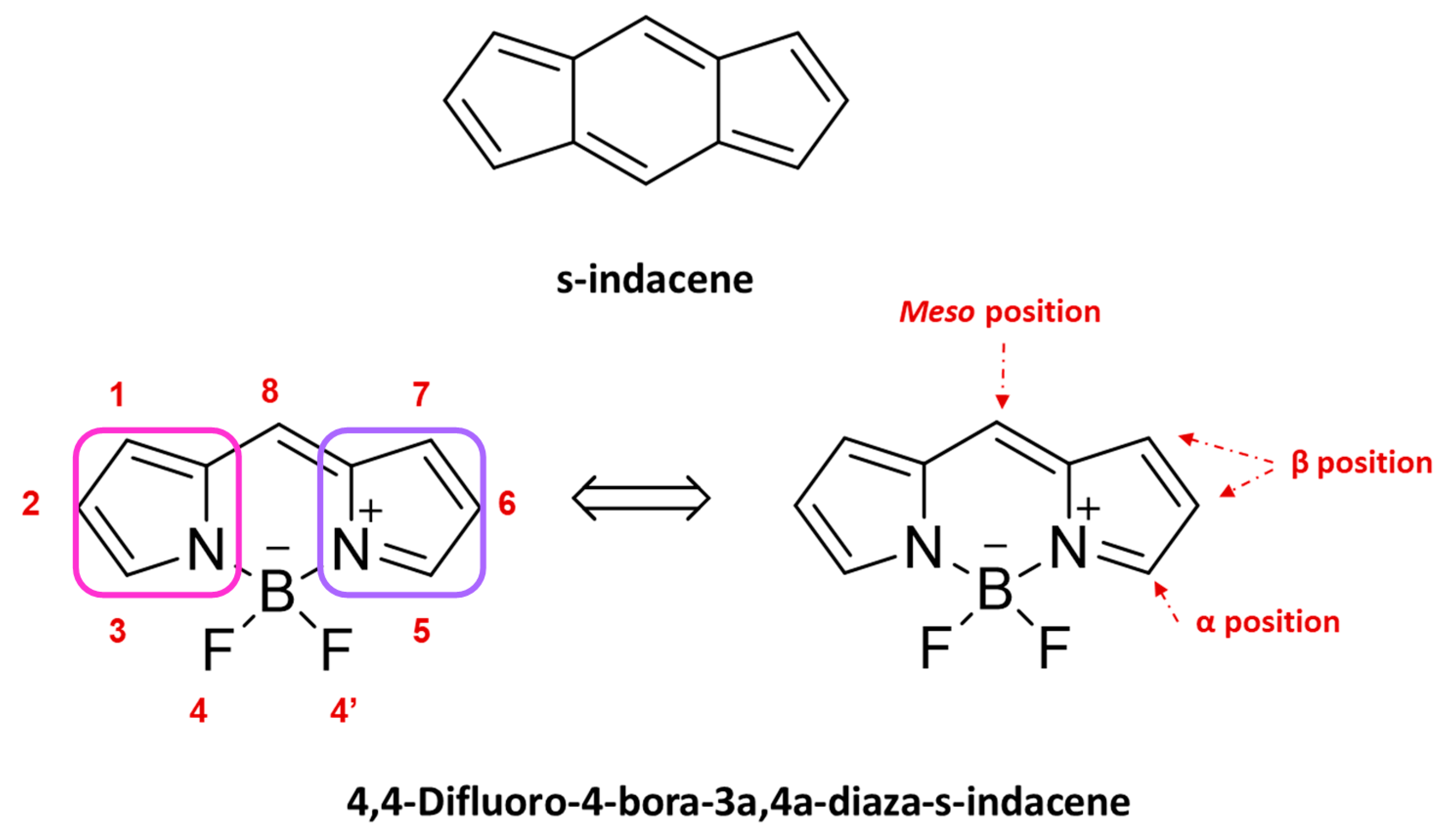
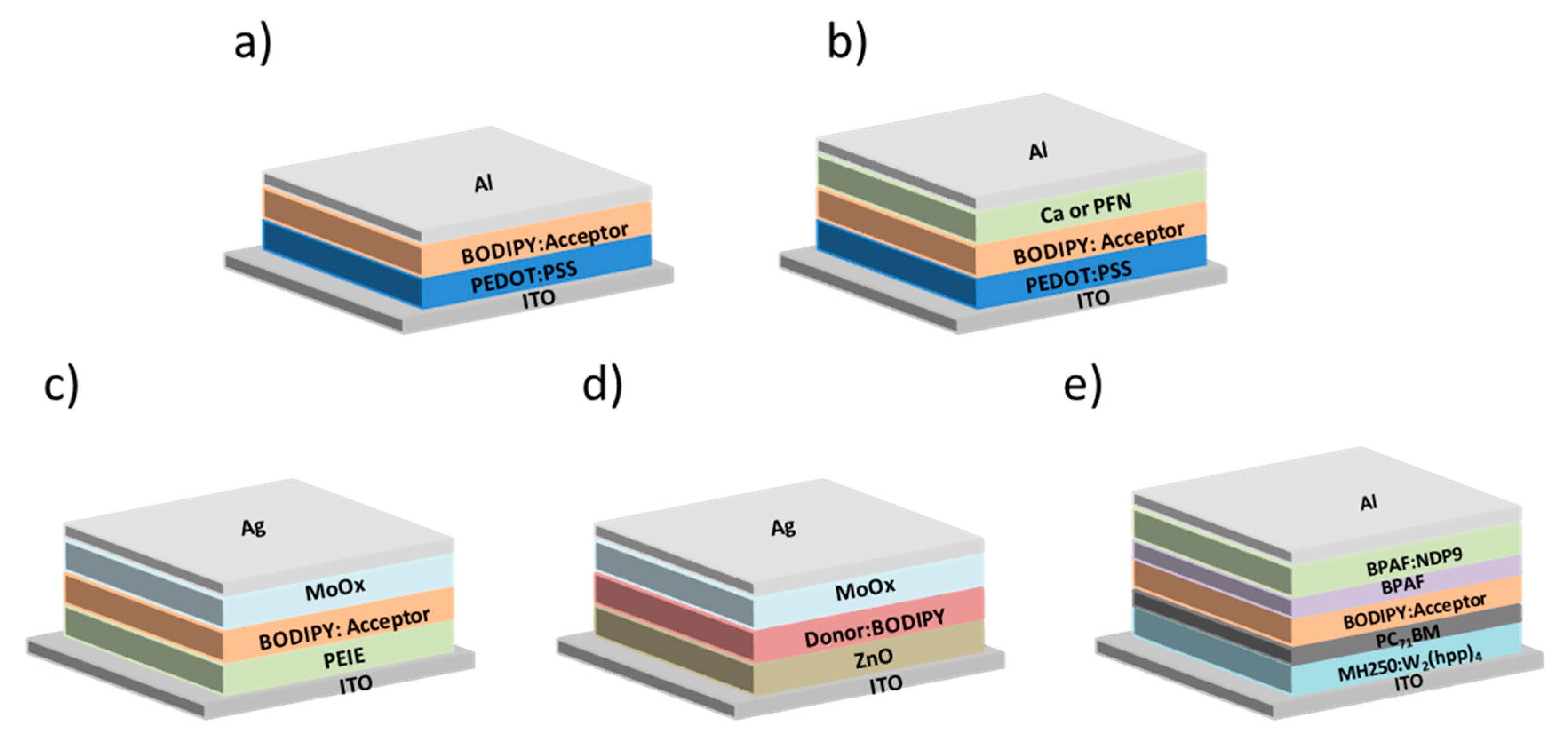



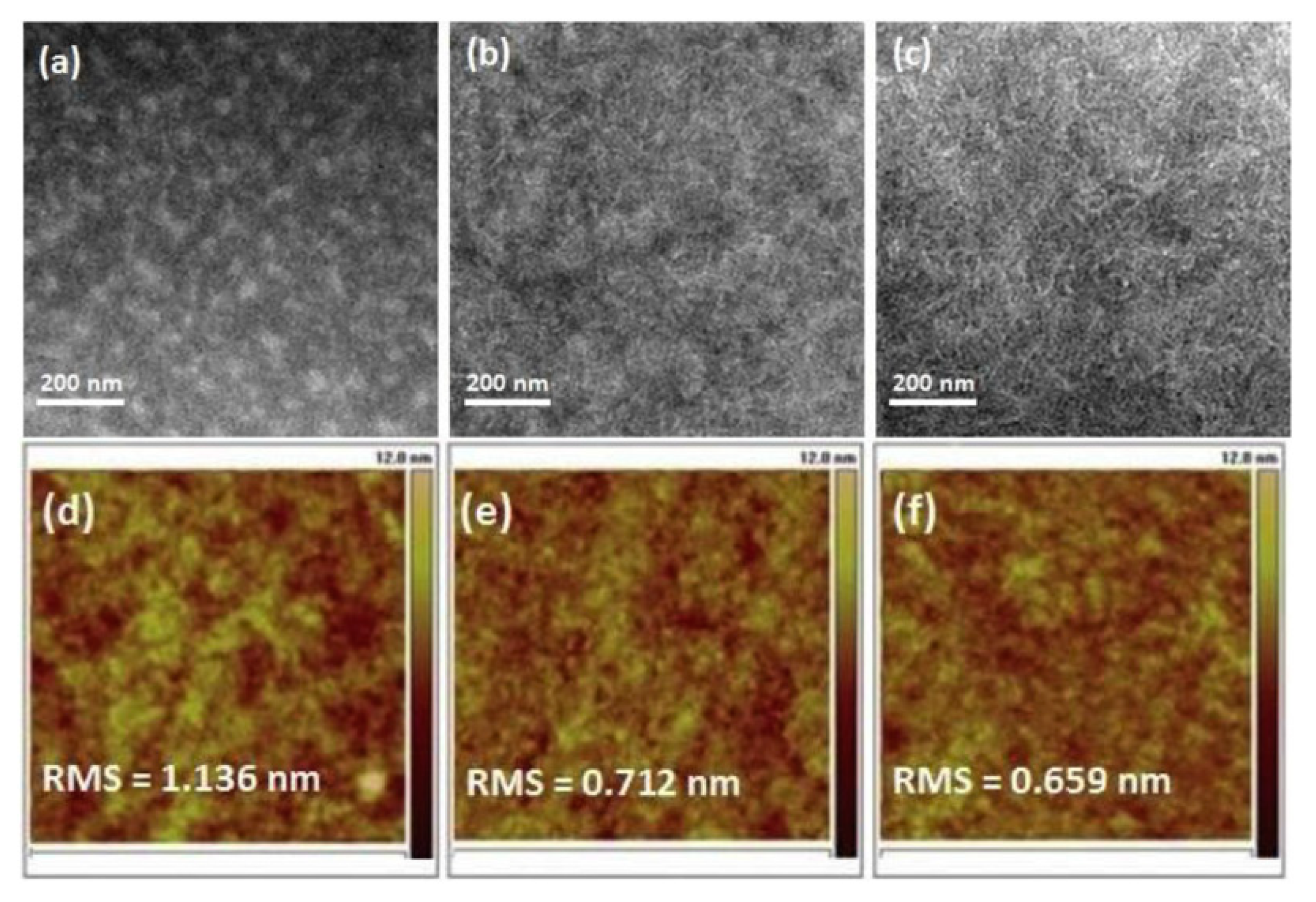
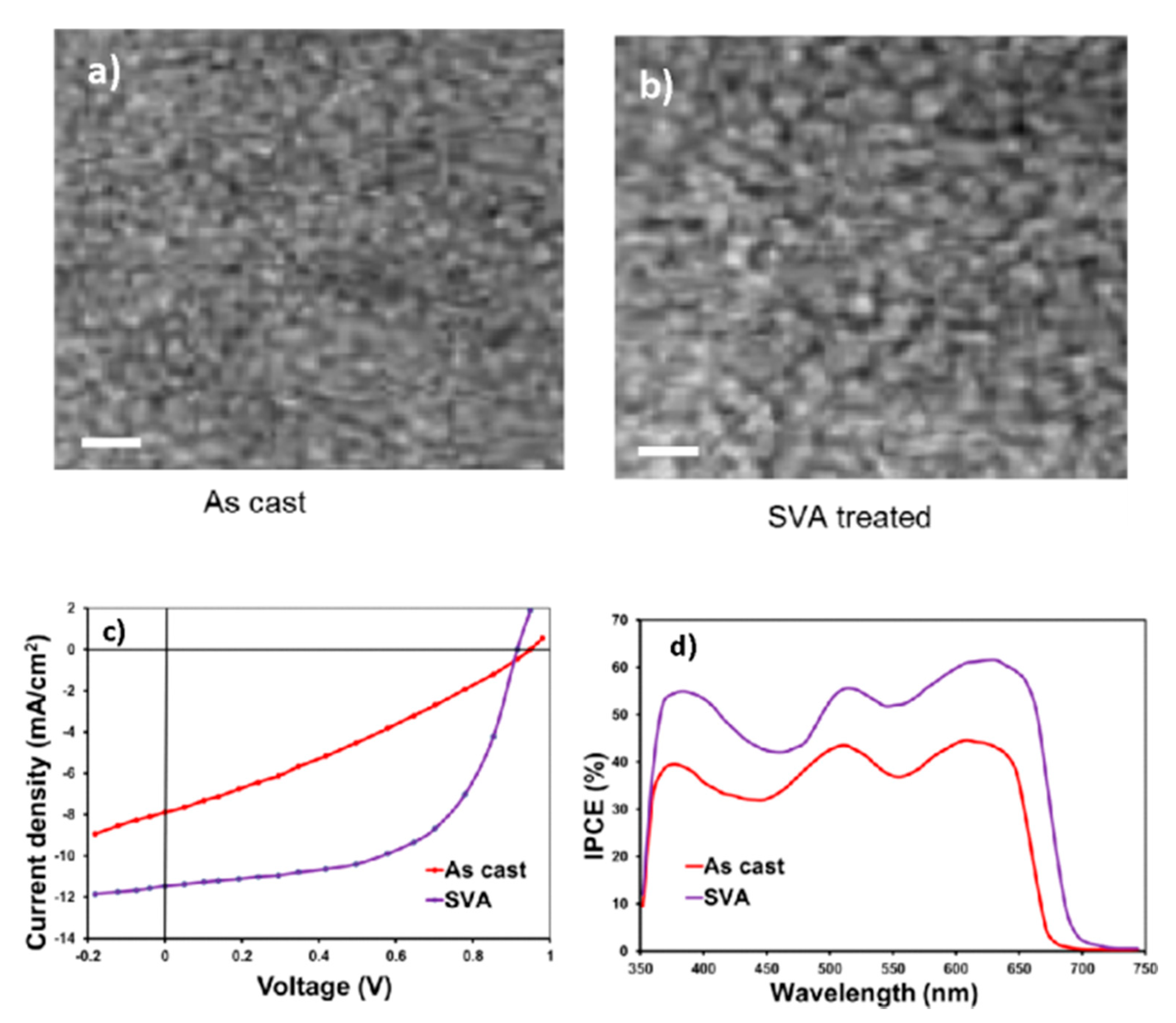
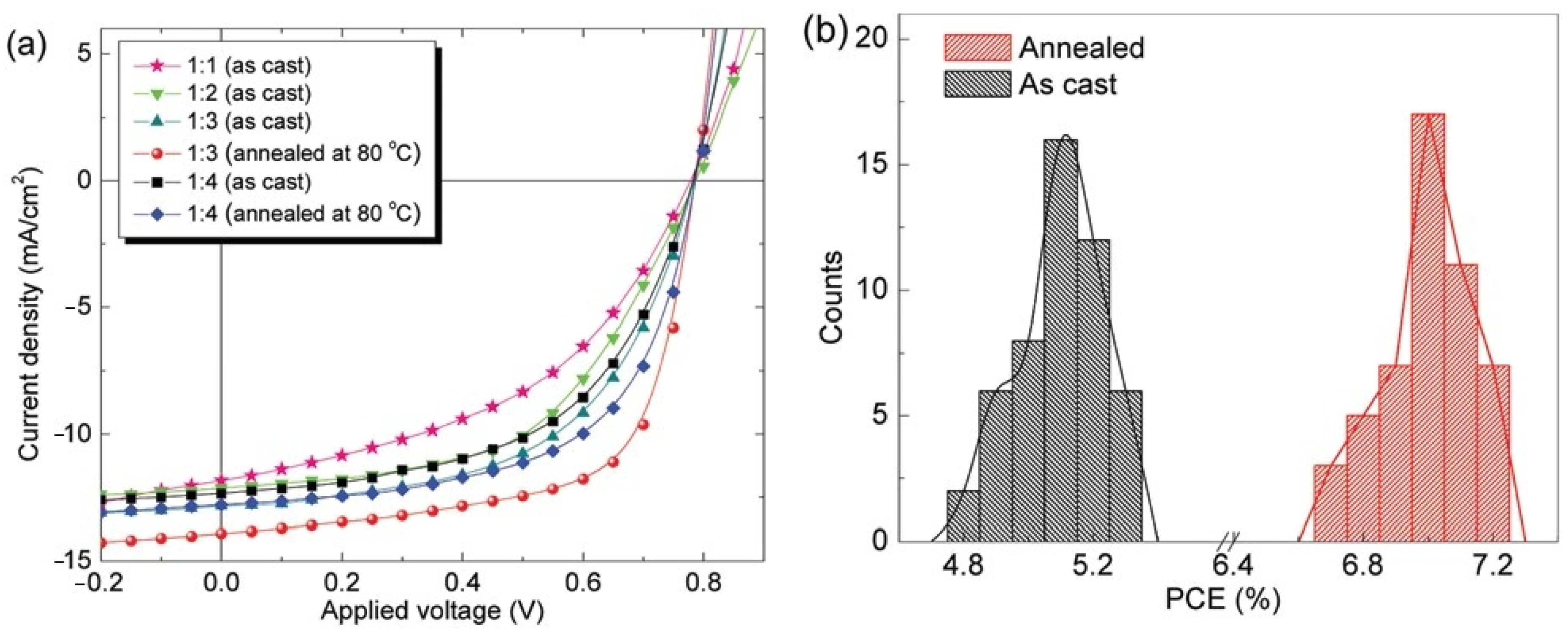
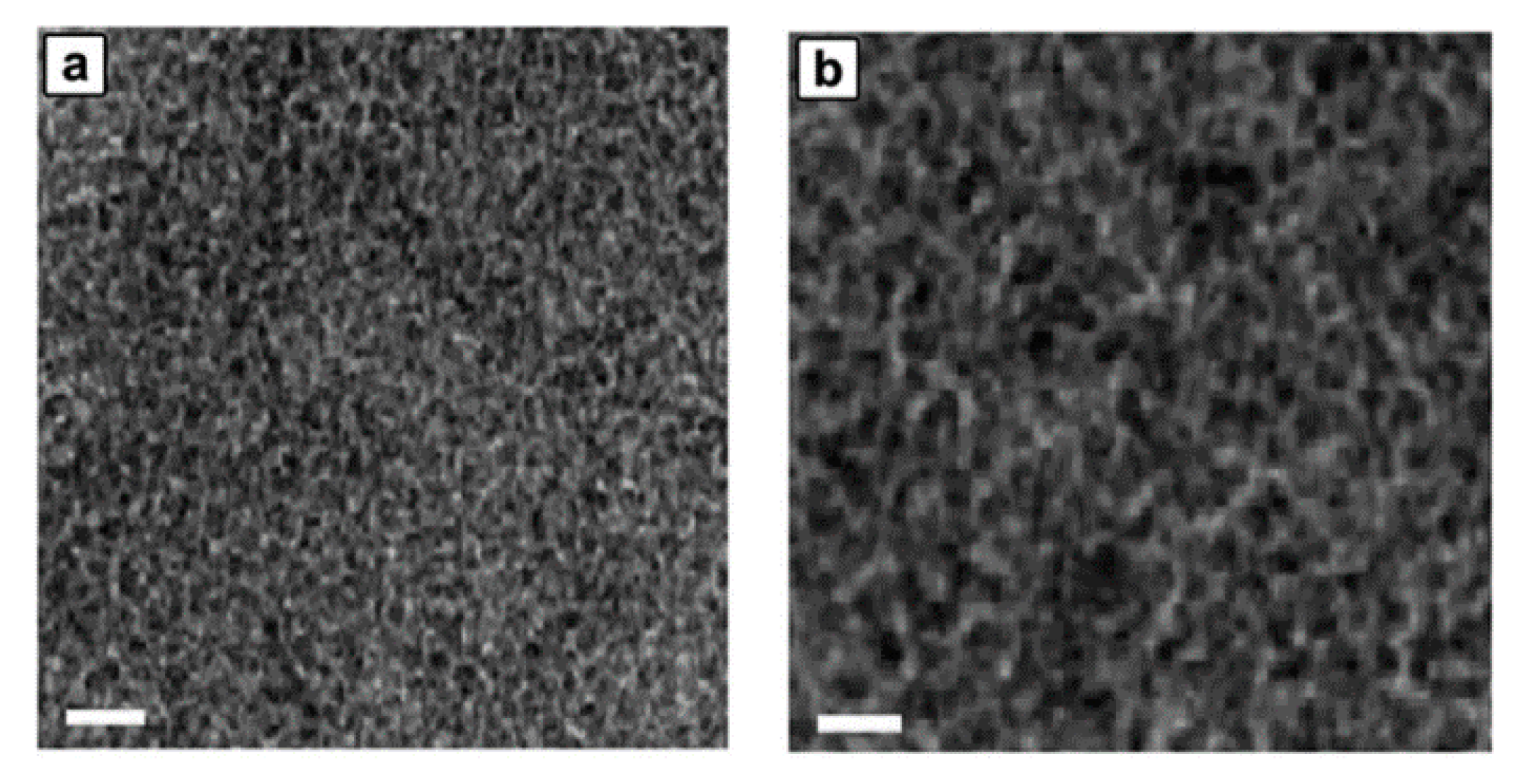
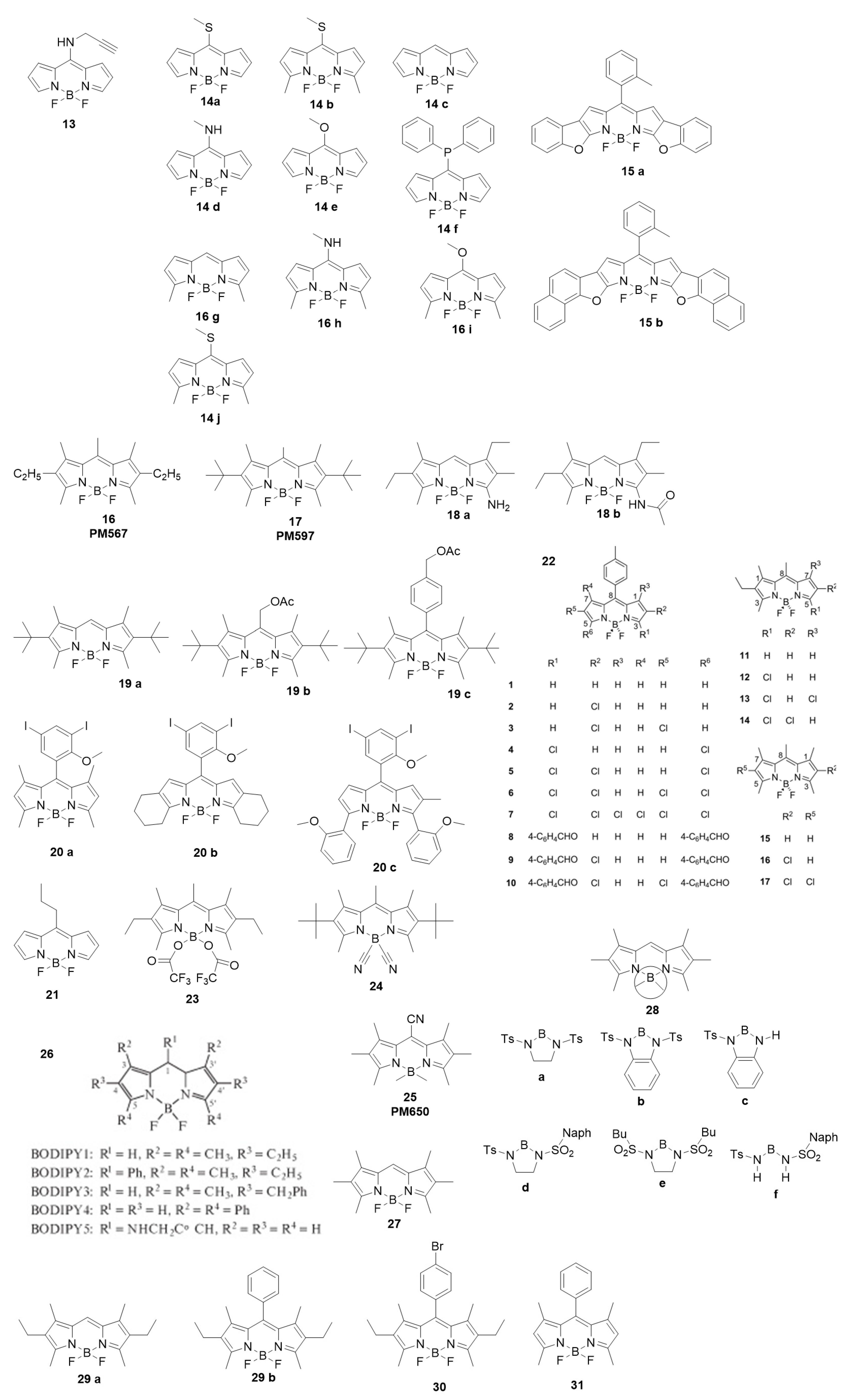

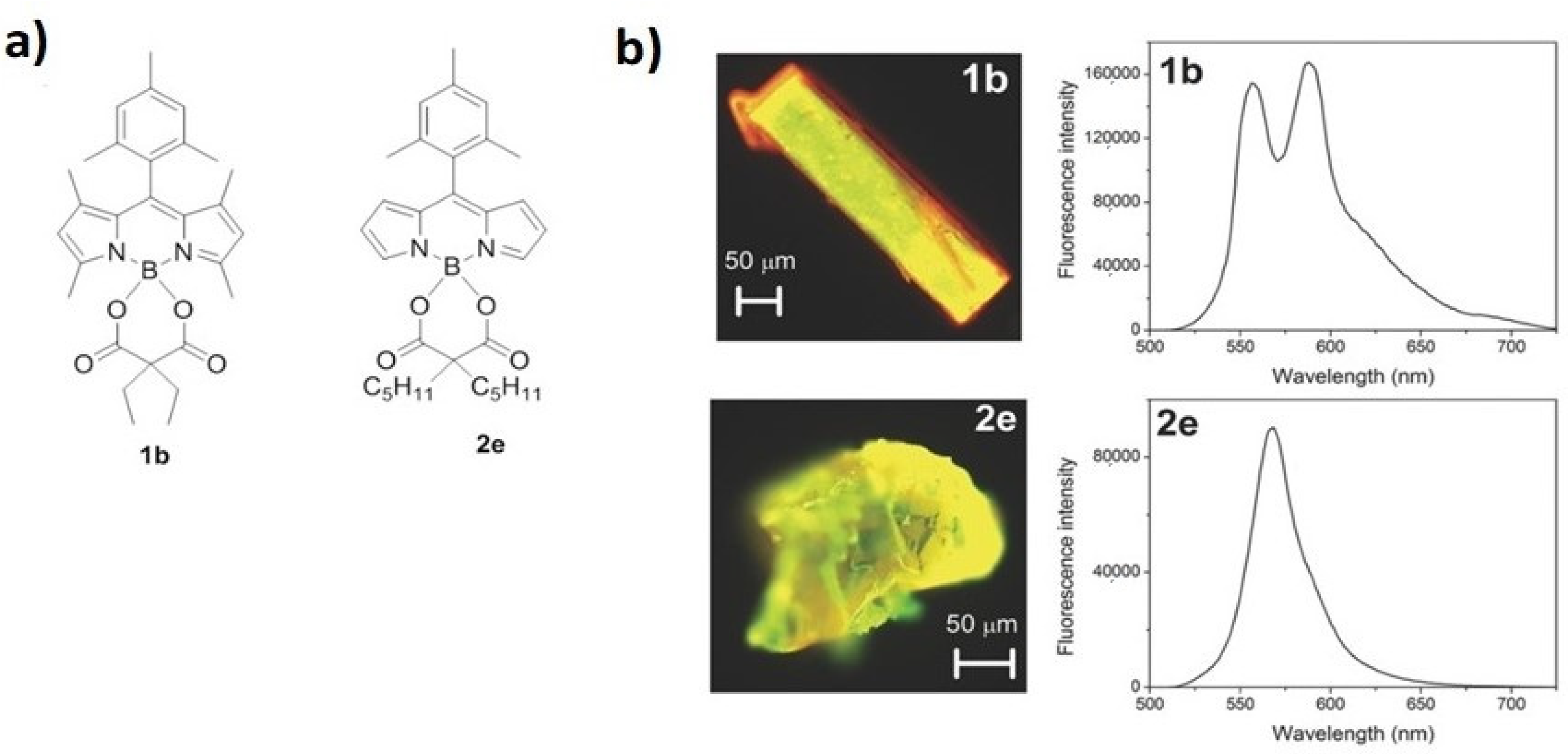
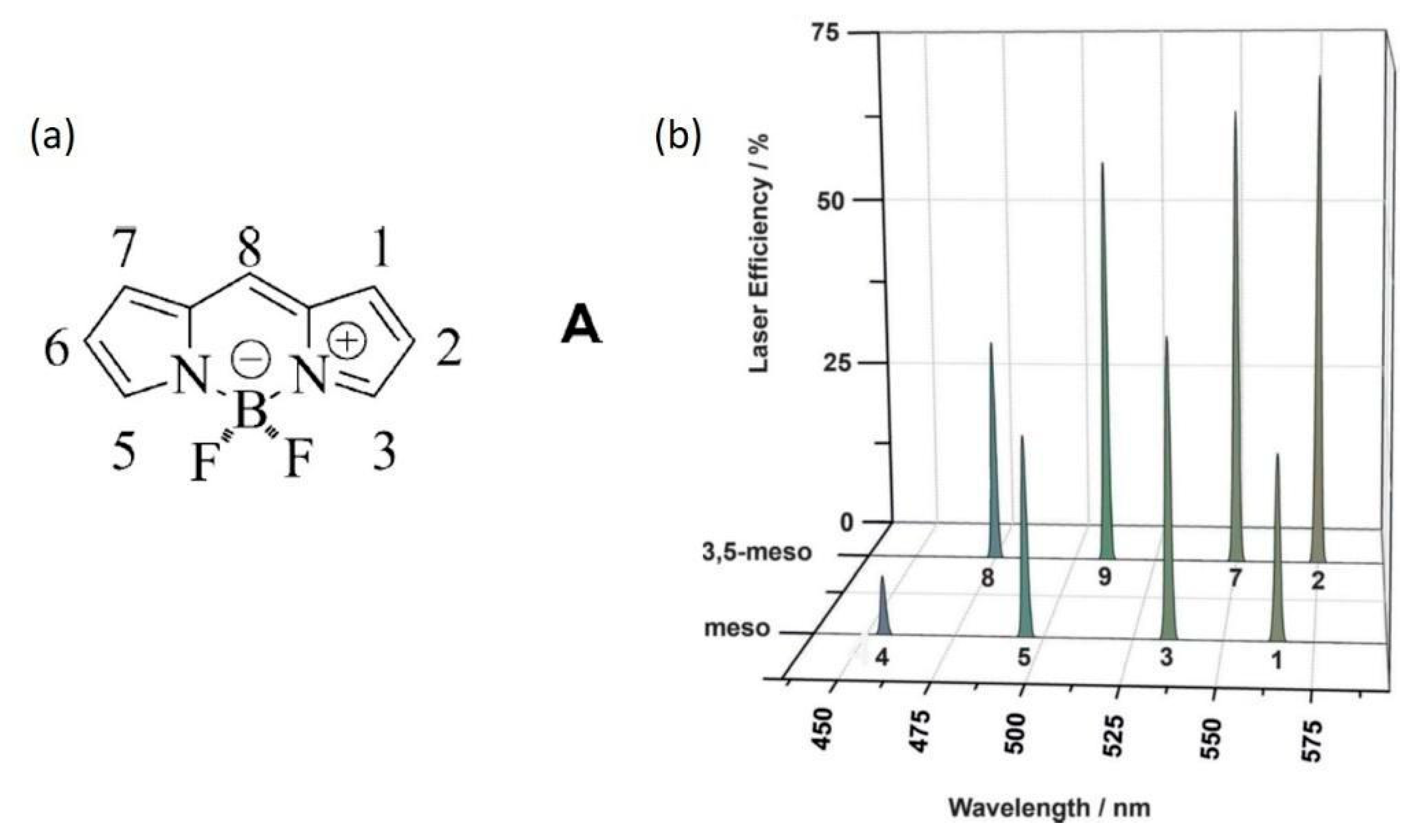
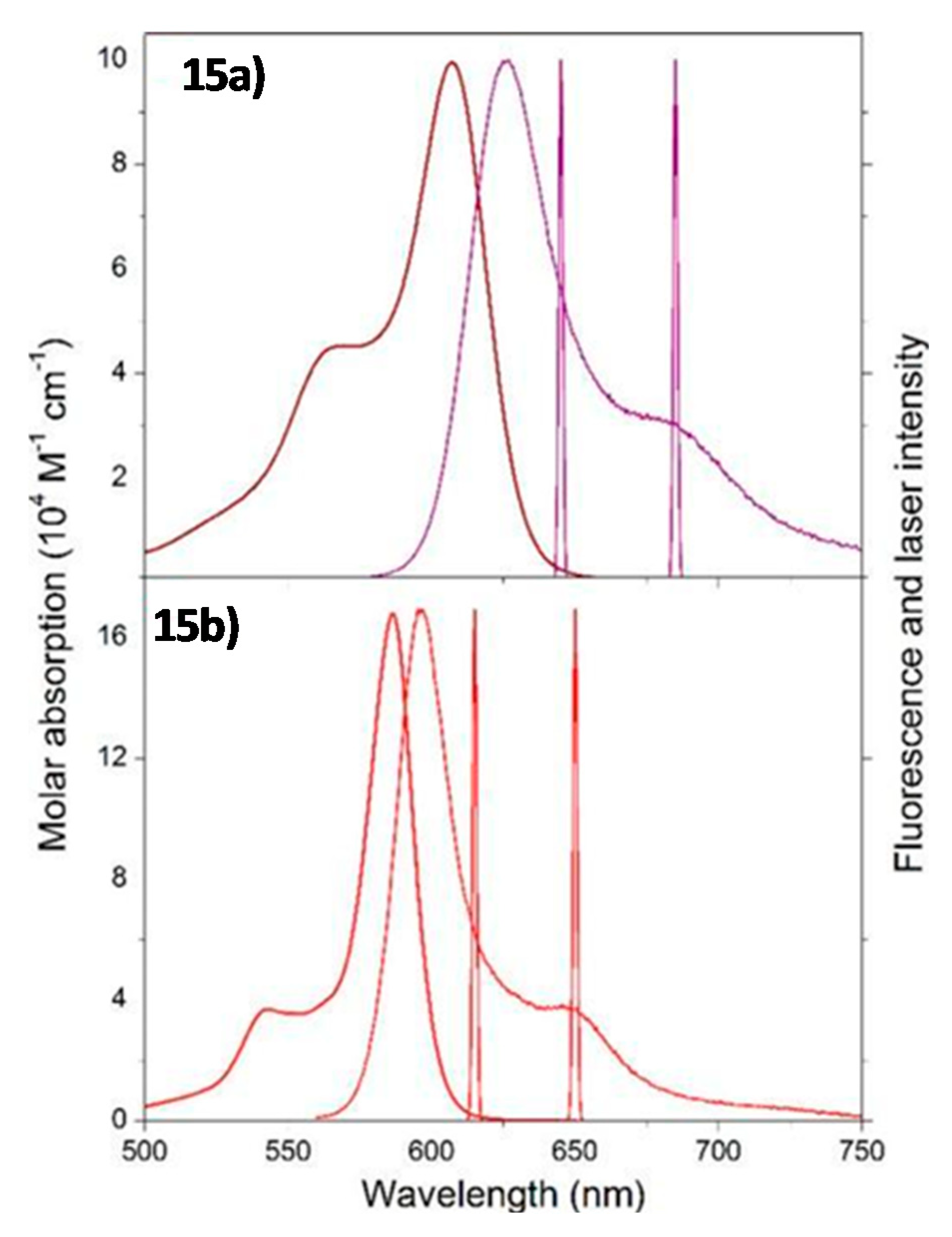
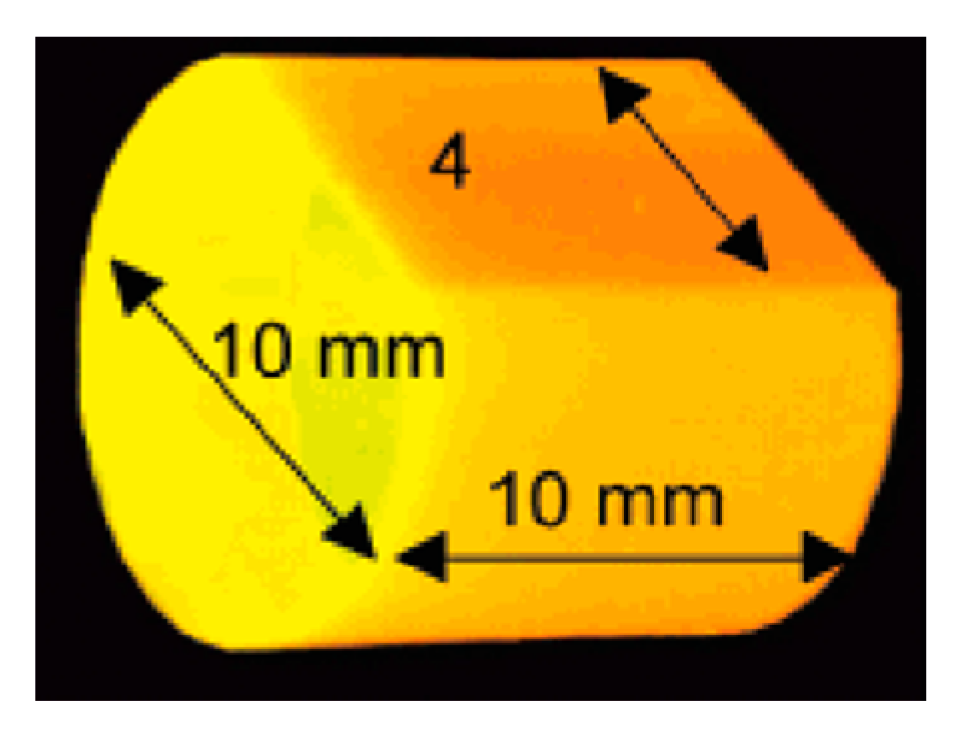
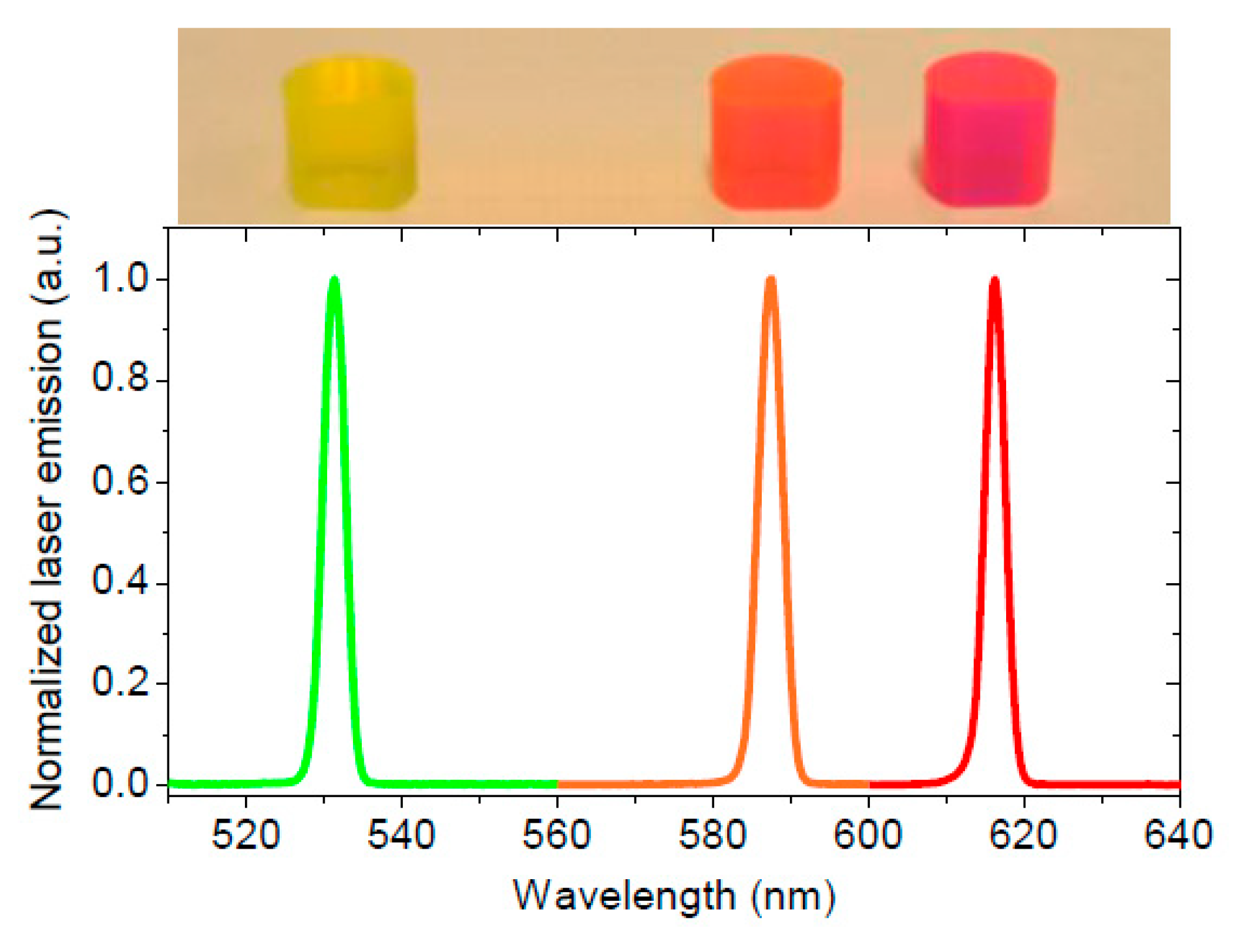
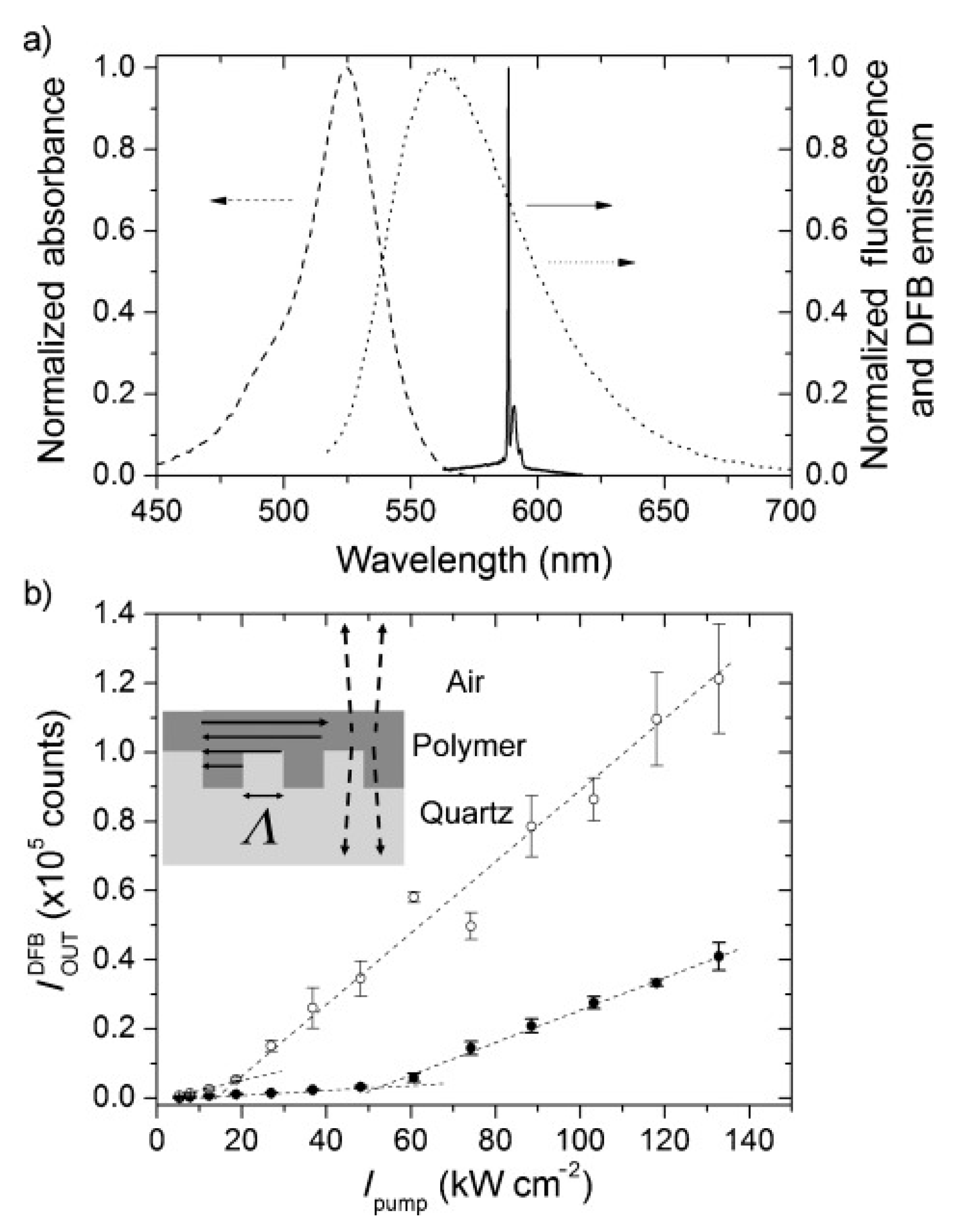
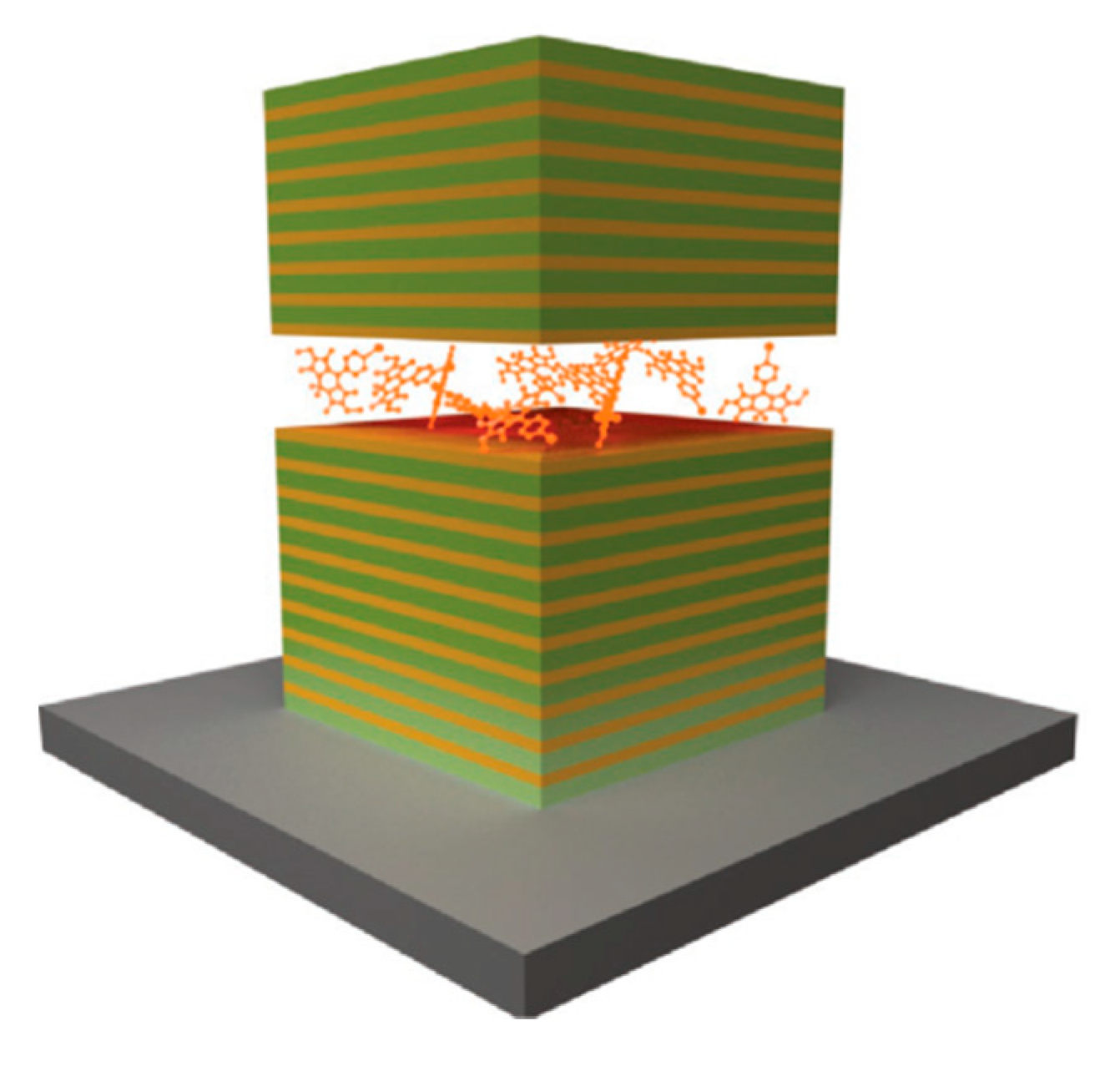
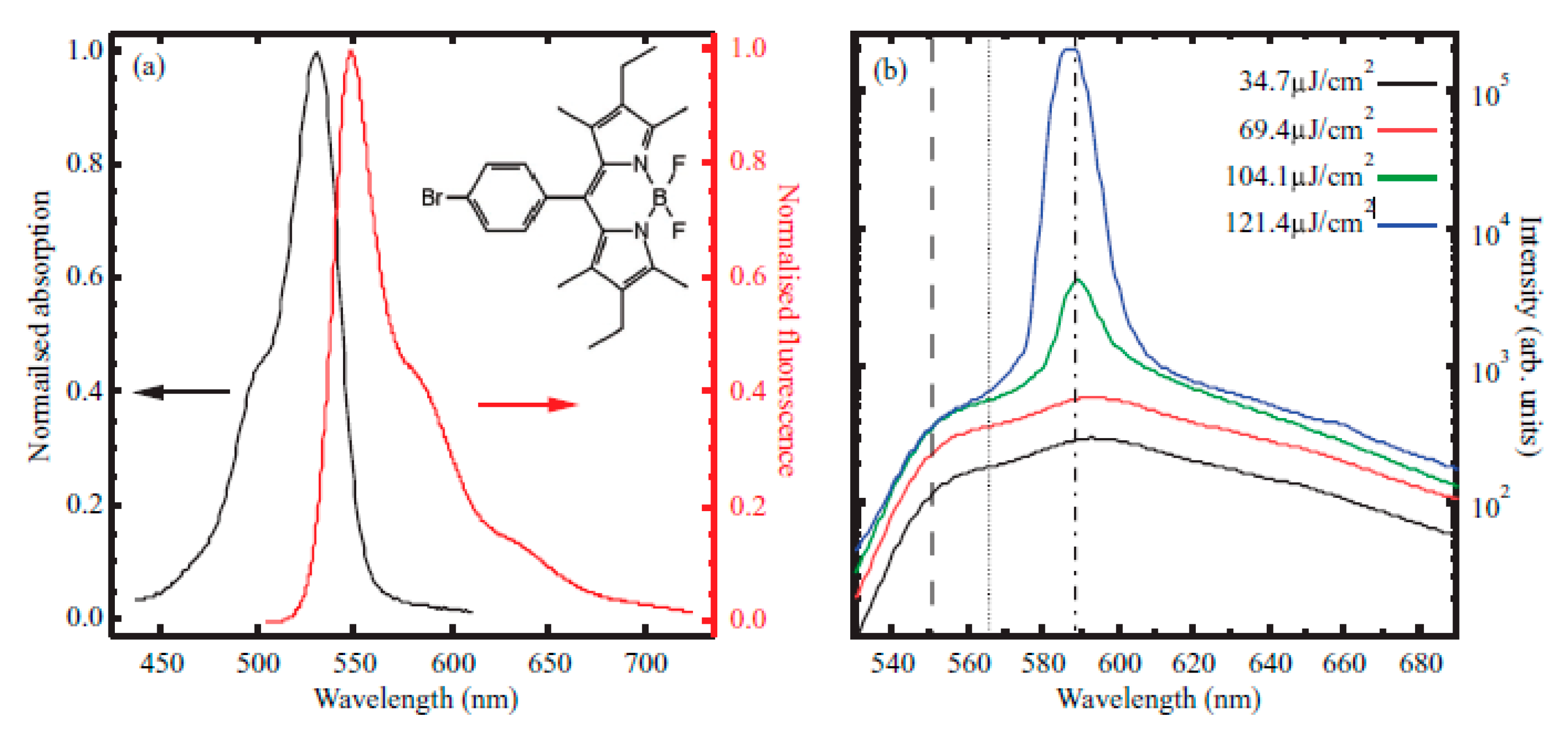
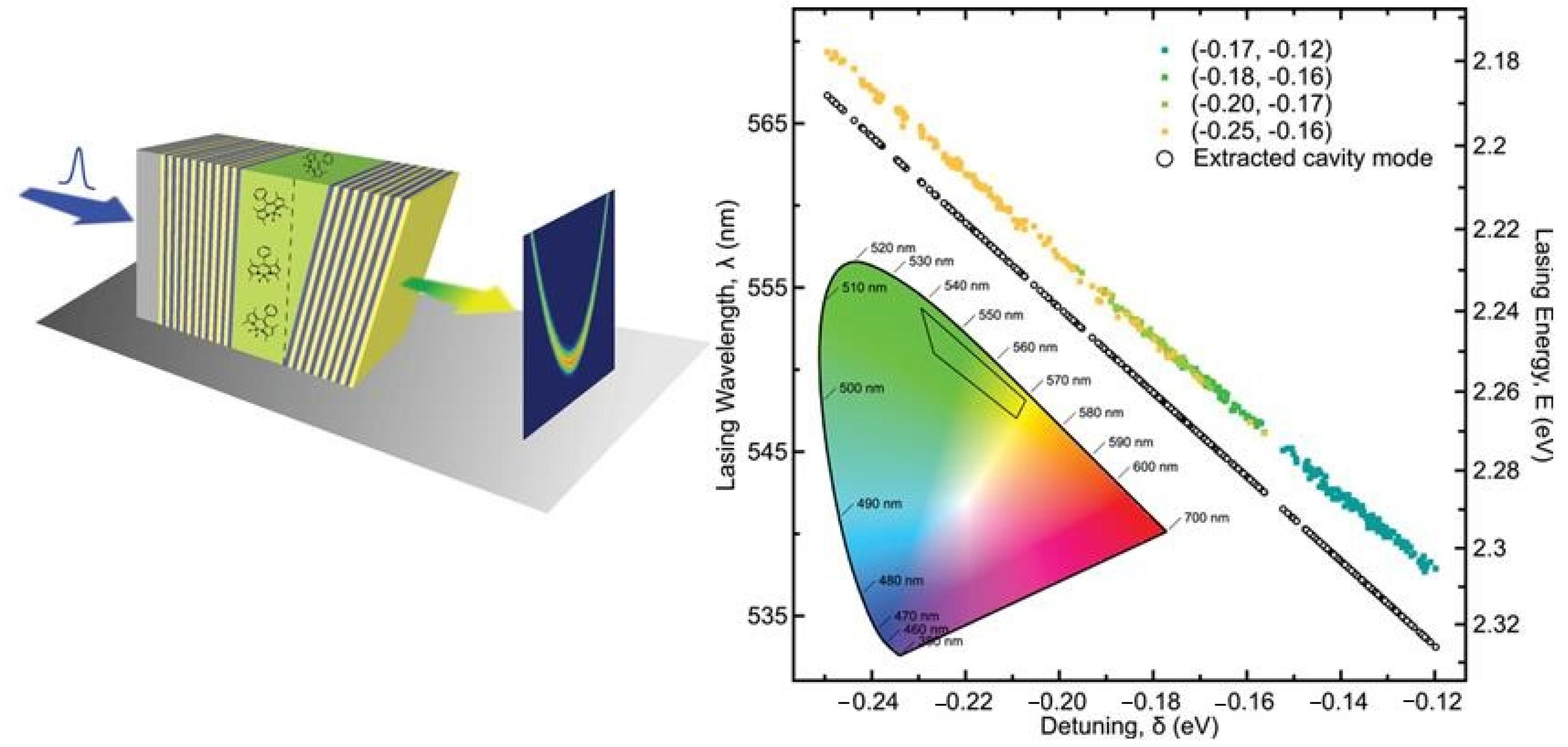
| Molecule | Efficiency | λLASER [nm] | λEXC [nm] | Power [mJ] | Reference |
|---|---|---|---|---|---|
| 16 | up to 30% | 559–564 | 534 | 5.5 | [96] |
| 16 | up to 36% | 561–564 | 532 | 5.5 | [95] |
| 17 | up to 42% | 576–579 | 532 | 5.5 | [95] |
| 18 | 25% | 563 | 532 | 5.5 | [97] |
| 19 | up to 48% | 559–609 | 532 | 5 | [98] |
| 20 | up to 45% | 530–615 | 515 or 532 | 5 | [99] |
| 21 | 29% | 522 | 355 | 5.5 | [100] |
| 22 | up to 30% | 565–615 | 532 | 5.5 | [101] |
| 23 | 56% | 568 | 532 | 5 | [102] |
| 24 | 53% | 588 | 532 | 5 | [103] |
| Molecule | λLASER [nm] | λEXC [nm] | Threshold [MW/cm2] | Reference |
|---|---|---|---|---|
| 23 | 570 | 532 | 1.7 × 10−3 | [78] |
| 24 | 588 | 532 | 20 × 10−3 | [101] |
| 25 | 680 | 580 | 0.34 | [102] |
| 26 | 562–566 | 532 | 3 | [103] |
| 27 | 557 | 532 | 10–20 | [104] |
| 28 | 569 | 532 | 17 × 10−3 | [105] |
| 29 | 562–566 | 532 | 3 | [106] |
Publisher’s Note: MDPI stays neutral with regard to jurisdictional claims in published maps and institutional affiliations. |
© 2020 by the authors. Licensee MDPI, Basel, Switzerland. This article is an open access article distributed under the terms and conditions of the Creative Commons Attribution (CC BY) license (http://creativecommons.org/licenses/by/4.0/).
Share and Cite
Squeo, B.M.; Ganzer, L.; Virgili, T.; Pasini, M. BODIPY-Based Molecules, a Platform for Photonic and Solar Cells. Molecules 2021, 26, 153. https://doi.org/10.3390/molecules26010153
Squeo BM, Ganzer L, Virgili T, Pasini M. BODIPY-Based Molecules, a Platform for Photonic and Solar Cells. Molecules. 2021; 26(1):153. https://doi.org/10.3390/molecules26010153
Chicago/Turabian StyleSqueo, Benedetta Maria, Lucia Ganzer, Tersilla Virgili, and Mariacecilia Pasini. 2021. "BODIPY-Based Molecules, a Platform for Photonic and Solar Cells" Molecules 26, no. 1: 153. https://doi.org/10.3390/molecules26010153
APA StyleSqueo, B. M., Ganzer, L., Virgili, T., & Pasini, M. (2021). BODIPY-Based Molecules, a Platform for Photonic and Solar Cells. Molecules, 26(1), 153. https://doi.org/10.3390/molecules26010153






